Trimble 5580090 900 MHz FHSS Radio with Bluetooth Transmitter User Manual SPSx50 ModularGPSRcvr UserGuide
Trimble Navigation Ltd 900 MHz FHSS Radio with Bluetooth Transmitter SPSx50 ModularGPSRcvr UserGuide
Trimble >
Contents
- 1. Users Manual Addendum
- 2. User Manual 1
- 3. User Manual 2
- 4. User Manual
User Manual 1

Version 1.0
Revision A
February 2006 F
USER GUIDE
Trimble® SPSx50 Modular GPS Receiver

Corporate Office
Trimble Navigation Limited
935 Stewart Drive
Sunnyvale, CA 94085
USA
www.trimble.com
Trimble Navigation Limited
Construction Business Area
5475 Kellenburger Road
Dayton, Ohio 45424-1099
USA
800-538-7800 (toll free in USA)
+1-937-245-5600 Phone
+1-937-233-9004 Fax
www.trimble.com
E-mail: trimble_support@trimble.com
Legal Notices
© 2006, Trimble Navigation Limited. All rights reserved.
Trimble, the Globe & Triangle logo, and <list Trimble registered
marks used in the text (alphabetically, numbers first)> are
trademarks of Trimble Navigation Limited, registered in the United
States Patent and Trademark Office and in other countries. <List
Trimble trademarks used in the text (alphabetically, numbers first)>
are trademarks of Trimble Navigation Limited.
The Bluetooth word mark and logos are owned by the Bluetooth
SIG, Inc. and any use of such marks by Trimble Navigation Limited
is under license.
If the product uses a ™ or ® Microsoft product, bug the text and insert
this statement here:
Microsoft and <***> are either registered trademarks or trademarks
of Microsoft Corporation in the United States and/or other
countries.
All other trademarks are the property of their respective owners.
Release Notice
This is the February 2006 release (Revision A) of the SPSx50
Modular GPS Receiver User Guide. It applies to version 1.0 of the
SPSx50 Modular GPS receiver.
Limited Warranty Terms and Conditions
Product Limited Warranty
Subject to the terms and conditions set forth herein, Trimble
Navigation Limited (“Trimble”) warrants that for a period of (1) year
from date of purchase this Trimble product (the “Product”) will
substantially conform to Trimble's publicly available specifications
for the Product and that the hardware and any storage media
components of the Product will be substantially free from defects in
materials and workmanship.
Product Software
Product software, whether built into hardware circuitry as
firmware, provided as a standalone computer software product,
embedded in flash memory, or stored on magnetic or other media,
is licensed and not sold. If accompanied by a separate end user
license agreement, use of any such software will be subject to the
terms of such end user license agreement (including any differing
limited warranty terms, exclusions and limitations), which shall
control over the terms and conditions set forth in this limited
warranty).
Software Updates
During the limited warranty period you will be entitled to receive
such Fix Updates and Minor Updates to the Product software that
Trimble releases and makes commercially available and for which it
does not charge separately, subject to the procedures for delivery to
purchasers of Trimble products generally. If you have purchased the
Product from an authorized Trimble distributor rather than from
Trimble directly, Trimble may, at its option, forward the software Fix
Update or Minor Update to the Trimble distributor for final
distribution to you. Major Upgrades, new products, or substantially
new software releases, as identified by Trimble are expressly
excluded from this update process and limited warranty. Receipt of
software updates shall not serve to extend the limited warranty
period.
For purposes of this warranty the following definitions shall apply:
(1) “Fix Update” means an error correction or other update created
to fix a previous software version that does not substantially
conform to its published specifications; (2) “Minor Update” occurs
when enhancements are made to current features in a software
program; and (3) “Major Upgrade” occurs when significant new
features are added to software, or when a new product containing
new features replaces the further development of a current product
line. Trimble reserves the right to determine, in its sole discretion,
what constitutes a significant new feature and Major Upgrade.
Warranty Remedies
If the Trimble Product fails during the warranty period for reasons
covered by this Limited Warranty and you notify Trimble of such
failure during the warranty period, Trimble at its option will repair
OR replace the nonconforming Product, OR refund the purchase
price paid by you for the Product, upon your return of the Product
to Trimble in accordance with Trimble's standard return material
authorization procedures.
How to Obtain Warranty Service
To obtain warranty service for the Product, please contact your
Trimble dealer. Alternatively, you may contact Trimble to request
warranty service at +1-408-481-6940 (24 hours a day) or e-mail your
request to trimble_support@trimble.com. Please be prepared to
provide:
– your name, address, and telephone numbers
– proof of purchase
–this Trimble warranty card
– a description of the nonconforming Product including the model
number
– an explanation of the problem.
The customer service representative may need additional
information from you depending on the nature of the problem.
Warranty Exclusions and Disclaimer
This Product limited warranty shall only apply in the event and to
the extent that (i) the Product is properly and correctly installed,
configured, interfaced, maintained, stored, and operated in
accordance with Trimble's applicable operator's manual and
specifications, and; (ii) the Product is not modified or misused. This
Product limited warranty shall not apply to, and Trimble shall not
be responsible for defects or performance problems resulting from
(i) the combination or utilization of the Product with hardware or
software products, information, data, systems, interfaces or devices
not made, supplied or specified by Trimble; (ii) the operation of the
Product under any specification other than, or in addition to,
Trimble's standard specifications for its products; (iii) the
unauthorized, installation, modification, or use of the Product; (iv)
damage caused by: accident, lightning or other electrical discharge,
fresh or salt water immersion or spray; or exposure to
environmental conditions for which the Product is not intended; or
(v) normal wear and tear on consumable parts (e.g., batteries).
Trimble does not warrant or guarantee the results obtained through
the use of the Product. NOTICE REGARDING PRODUCTS
EQUIPPED WITH GPS TECHNOLOGY: TRIMBLE IS NOT
RESPONSIBLE FOR THE OPERATION OR FAILURE OF
OPERATION OF GPS SATELLITES OR THE AVAILABILITY OF GPS
SATELLITE SIGNALS.
THE FOREGOING LIMITED WARRANTY TERMS STATE
TRIMBLE'S ENTIRE LIABILITY, AND YOUR EXCLUSIVE
REMEDIES, RELATING TO PERFORMANCE OF THE TRIMBLE
PRODUCT. EXCEPT AS OTHERWISE EXPRESSLY PROVIDED
HEREIN, THE PRODUCT AND ACCOMPANYING
DOCUMENTATION AND MATERIALS ARE PROVIDED “AS-IS”
AND WITHOUT EXPRESS OR IMPLIED WARRANTY OF ANY
KIND, BY EITHER TRIMBLE OR ANYONE WHO HAS BEEN
INVOLVED IN ITS CREATION, PRODUCTION, INSTALLATION, OR
DISTRIBUTION, INCLUDING, BUT NOT LIMITED TO, THE
IMPLIED WARRANTIES OF MERCHANTABILITY AND FITNESS
FOR A PARTICULAR PURPOSE, TITLE, AND
NONINFRINGEMENT. THE STATED EXPRESS WARRANTIES ARE
IN LIEU OF ALL OBLIGATIONS OR LIABILITIES ON THE PART OF
TRIMBLE ARISING OUT OF, OR IN CONNECTION WITH, ANY
PRODUCT.
SOME STATES AND JURISDICTIONS DO NOT ALLOW
LIMITATIONS ON DURATION OR THE EXCLUSION OF AN
IMPLIED WARRANTY, SO THE ABOVE LIMITATION MAY NOT
APPLY TO YOU.
Limitation of Liability
TRIMBLE'S ENTIRE LIABILITY UNDER ANY PROVISION HEREIN
SHALL BE LIMITED TO THE AMOUNT PAID BY YOU FOR THE
PRODUCT. TO THE MAXIMUM EXTENT PERMITTED BY
APPLICABLE LAW, IN NO EVENT SHALL TRIMBLE OR ITS SUPPLIERS
BE LIABLE FOR ANY INDIRECT, SPECIAL, INCIDENTAL OR
CONSEQUENTIAL DAMAGE WHATSOEVER UNDER ANY
CIRCUMSTANCE OR LEGAL THEORY RELATING IN ANYWAY TO THE
PRODUCTS, SOFTWARE AND ACCOMPANYING DOCUMENTATION
AND MATERIALS, (INCLUDING, WITHOUT LIMITATION, DAMAGES
FOR LOSS OF BUSINESS PROFITS, BUSINESS INTERRUPTION, LOSS
OF DATA, OR ANY OTHER PECUNIARY LOSS), REGARDLESS OF
WHETHER TRIMBLE HAS BEEN ADVISED OF THE POSSIBILITY OF
ANY SUCH LOSS AND REGARDLESS OF THE COURSE OF DEALING

WHICH DEVELOPS OR HAS DEVELOPED BETWEEN YOU AND
TRIMBLE. BECAUSE SOME STATES AND JURISDICTIONS DO NOT
ALLOW THE EXCLUSION OR LIMITATION OF LIABILITY FOR
CONSEQUENTIAL OR INCIDENTAL DAMAGES, THE ABOVE
LIMITATION MAY NOT APPLY TO YOU.
PLEASE NOTE: THE ABOVE TRIMBLE LIMITED WARRANTY
PROVISIONS WILL NOT APPLY TO PRODUCTS PURCHASED
IN THOSE JURISDICTIONS, SUCH AS COUNTRIES OF THE
EUROPEAN ECONOMIC COMMUNITY, IN WHICH PRODUCT
WARRANTIES ARE OBTAINED FROM THE LOCAL
DISTRIBUTOR. IN SUCH CASE, PLEASE CONTACT YOUR
TRIMBLE DEALER FOR APPLICABLE WARRANTY
INFORMATION.
Registration
To receive information regarding updates and new products, please
contact your local dealer or visit the Trimble website at
www.trimble.com/register. Upon registration you may select the
newsletter, upgrade or new product information you desire.
Notices
Class B Statement – Notice to Users. This equipment has been
tested and found to comply with the limits for a Class B digital
device, pursuant to Part 15 of the FCC rules. These limits are
designed to provide reasonable protection against harmful
interference in a residential installation. This equipment generates,
uses, and can radiate radio frequency energy and, if not installed
and used in accordance with the instructions, may cause harmful
interference to radio communication. However, there is no
guarantee that interference will not occur in a particular
installation. If this equipment does cause harmful interference to
radio or television reception, which can be determined by turning
the equipment off and on, the user is encouraged to try to correct
the interference by one or more of the following measures:
– Reorient or relocate the receiving antenna.
– Increase the separation between the equipment and the receiver.
– Connect the equipment into an outlet on a circuit different from
that to which the receiver is connected.
– Consult the dealer or an experienced radio/TV technician for
help.
Changes and modifications not expressly approved by the
manufacturer or registrant of this equipment can void your
authority to operate this equipment under Federal
Communications Commission rules.
Canada
This Class B digital apparatus complies with Canadian ICES-003.
Cet appareil numérique de la classe B est conforme à la norme
NMB-003 du Canada.
Europe
This product (the SPSx50 Modular GPS receiver) is
intended to be used in all EU member countries.
This product has been tested and found to comply with the
requirements for a Class B device pursuant to European Council
Directive 89/336/EEC on EMC, thereby satisfying the requirements
for CE Marking and sale within the European Economic Area (EEA).
Contains Infineon radio module ROK 104001. These requirements
are designed to provide reasonable protection against harmful
interference when the equipment is operated in a residential or
commercial environment.
Australia and New Zealand
This product conforms with the regulatory requirements of
the Australian Communications Authority (ACA) EMC
framework, thus satisfying the requirements for C-Tick
Marking and sale within Australia and New Zealand.
(5) Are Taiwanese battery recycling requirements required? Yes/No
Taiwan – Battery Recycling Requirements
The product contains a removable Lithium-ion battery.
Taiwanese regulations require that waste batteries are
recycled.
Directive 1999/5/EC
Hereby, Trimble Navigation, declares that the SPSx50 GPS Receiver
is in compliance with the essential requirements and other relevant
provisions of Directive 1999/5/EC.
Notice to Our European Union Customers
For product recycling instructions and more information, please go
to www.trimble.com/ev.shtml.
Recycling in Europe: To recycle Trimble WEEE (Waste
Electrical and Electronic Equipment, products that run on
electrical power.), Call +31 497 53 24 30, and ask for the
"WEEE Associate". Or, mail a request for recycling
instructions to:
Trimble Europe BV
c/o Menlo Worldwide Logistics
Meerheide 45
5521 DZ Eersel, NL

iv SPSx50 Modular GPS Receiver User Guide

SPSx50 Modular GPS Receiver User Guide v
Safety Information
Before you use the SPS GPS receivers, make sure that you have read and understood all
safety requirements.
Regulations and safety
The Bluetooth module inside the SPSx50 Modular GPS receiver, the SPSx80 Smart GPS
antenna, and the ACU, TSC2, and TCU controllers is a radio-modem transmitter and
receiver.
Regulations regarding the use of the radio-modems vary greatly from country to
country. In some countries, the unit can be used without obtaining an end-user license.
Other countries require end-user licensing. For licensing information, consult your
local Trimble dealer.
Before operating an SPSx50 Modular GPS receiver or SPSx80 Smart GPS antenna,
determine if authorization or a license to operate the unit is required in your country. It
is the responsibility of the end user to obtain an operator’s permit or license for the
receiver for the location or country of use.
For FCC regulations, see Notices, page iii.
*****Query from RobMiller - SPSx50 and SPSx80 receivers also contain internal
transmit radios. Does this information apply to them as well? If not - more needs to be
added here.
Type approval
Type approval, or acceptance, covers technical parameters of the equipment related to
emissions that can cause interference. Type approval is granted to the manufacturer of
the transmission equipment, independent from the operation or licensing of the units.
Some countries have unique technical requirements for operation in particular
radiomodem frequency bands. To comply with those requirements, Trimble may have
modified your equipment to be granted Type approval. Unauthorized modification of
the units voids the Type approval, the warranty, and the operational license of the
equipment.
Exposure to radio frequency radiation
The radiated output power of the internal Bluetooth wireless radio is far below the
FCC radio frequency exposure limits.
Nevertheless, the wireless radio shall be used in such a manner that the Trimble
receiver is 2.0 cm or further from the human body. The internal wireless radio operates
within guidelines found in radio frequency safety standards and recommendations,

Safety Information
vi SPSx50 Modular GPS Receiver User Guide
which reflect the consensus of the scientific community. Trimble therefore believes the
internal wireless radio is safe for use by consumers. The level of energy emitted is far
less than the electromagnetic energy emitted by wireless devices such as mobile
phones. However, the use of wireless radios may be restricted in some situations or
environments, such as on aircraft. If you are unsure of restrictions, you are encouraged
to ask for authorization before turning on the wireless radio.
*****Query from RobMiller - SPSx50 and SPSx80 receivers also contain internal
transmit radios. Does this information apply to them as well? If not - more needs to be
added here.
Battery safety
CWARNING – Do not damage the rechargeable Lithium-ion battery. A damaged battery
can cause an explosion or fire, and can result in personal injury and/or property damage.
To prevent injury or damage:
– Do not use or charge the battery if it appears to be damaged. Signs of damage include,
but are not limited to, discoloration, warping, and leaking battery fluid.
– Do not expose the battery to fire, high temperature, or direct sunlight.
– Do not immerse the battery in water.
– Do not use or store the battery inside a vehicle during hot weather.
– Do not drop or puncture the battery.
– Do not open the battery or short-circuit its contacts.
CWARNING – Avoid contact with the rechargeable Lithium-ion battery if it appears to be
leaking. Battery fluid is corrosive, and contact with it can result in personal injury and/or
property damage.
To prevent injury or damage:
– If the battery leaks, avoid contact with the battery fluid.
– If battery fluid gets into your eyes, immediately rinse your eyes with clean water and
seek medical attention. Do not rub your eyes!
– If battery fluid gets onto your skin or clothing, immediately use clean water to wash off
the battery fluid.
CWARNING – Charge and use the rechargeable Lithium-ion battery only in strict
accordance with the instructions. Charging or using the battery in unauthorized
equipment can cause an explosion or fire, and can result in personal injury and/or
equipment damage.
To prevent injury or damage:
– Do not charge or use the battery if it appears to be damaged or leaking.
– Charge the Lithium-ion battery only in a Trimble product that is specified to charge it.
Be sure to follow all instructions that are provided with the battery charger.
– Discontinue charging a battery that gives off extreme heat or a burning odor.
– Use the battery only in Trimble equipment that is specified to use it.
– Use the battery only for its intended use and according to the instructions in the product
documentation.
SPSx50 Modular GPS Receiver User Guide vii
Contents
Safety Information . . . . . . . . . . . . . . . . . . . . . . . . . . . . . . . . v
Regulations and safety . . . . . . . . . . . . . . . . . . . . . . . . . . . . . . . . . . . . . . . . . . . . . . . v
Type approval . . . . . . . . . . . . . . . . . . . . . . . . . . . . . . . . . . . . . . . . . . . . . . . . . . . . v
Exposure to radio frequency radiation. . . . . . . . . . . . . . . . . . . . . . . . . . . . . . . . . . . . . v
Battery safety. . . . . . . . . . . . . . . . . . . . . . . . . . . . . . . . . . . . . . . . . . . . . . . . . . . . . vi
1 Introduction . . . . . . . . . . . . . . . . . . . . . . . . . . . . . . . . . . . 13
About the SPSx50 receivers. . . . . . . . . . . . . . . . . . . . . . . . . . . . . . . . . . . . . . . . . . . 13
SPS550 GPS receiver . . . . . . . . . . . . . . . . . . . . . . . . . . . . . . . . . . . . . . . . . . . 13
SPS550H GPS receiver . . . . . . . . . . . . . . . . . . . . . . . . . . . . . . . . . . . . . . . . . . 13
SPS750 GPS receiver . . . . . . . . . . . . . . . . . . . . . . . . . . . . . . . . . . . . . . . . . . . 13
SPS850 Extreme GPS receiver . . . . . . . . . . . . . . . . . . . . . . . . . . . . . . . . . . . . . 14
Related Information . . . . . . . . . . . . . . . . . . . . . . . . . . . . . . . . . . . . . . . . . . . . . . . 14
Technical Support. . . . . . . . . . . . . . . . . . . . . . . . . . . . . . . . . . . . . . . . . . . . . . . . . 14
Your Comments . . . . . . . . . . . . . . . . . . . . . . . . . . . . . . . . . . . . . . . . . . . . . . . . . . 14
2 Features and Functions . . . . . . . . . . . . . . . . . . . . . . . . . . . . . 15
SPS550 features . . . . . . . . . . . . . . . . . . . . . . . . . . . . . . . . . . . . . . . . . . . . . . . . . . 16
SPS550H features . . . . . . . . . . . . . . . . . . . . . . . . . . . . . . . . . . . . . . . . . . . . . . . . . 17
SPS750 features . . . . . . . . . . . . . . . . . . . . . . . . . . . . . . . . . . . . . . . . . . . . . . . . . . 17
SPS750 standard features . . . . . . . . . . . . . . . . . . . . . . . . . . . . . . . . . . . . . . . 17
SPS750 Basic. . . . . . . . . . . . . . . . . . . . . . . . . . . . . . . . . . . . . . . . . . . . . . . . 18
SPS750 Max . . . . . . . . . . . . . . . . . . . . . . . . . . . . . . . . . . . . . . . . . . . . . . . . 19
SPS850 features . . . . . . . . . . . . . . . . . . . . . . . . . . . . . . . . . . . . . . . . . . . . . . . . . . 19
SPS850 Extreme features . . . . . . . . . . . . . . . . . . . . . . . . . . . . . . . . . . . . . . . . 20
Use and care . . . . . . . . . . . . . . . . . . . . . . . . . . . . . . . . . . . . . . . . . . . . . . . . . . . . 21
COCOM limits . . . . . . . . . . . . . . . . . . . . . . . . . . . . . . . . . . . . . . . . . . . . . . . . . . . 21
Keypad and display . . . . . . . . . . . . . . . . . . . . . . . . . . . . . . . . . . . . . . . . . . . . . . . . 22
Rear connectors . . . . . . . . . . . . . . . . . . . . . . . . . . . . . . . . . . . . . . . . . . . . . . . . . . 23
Button functions . . . . . . . . . . . . . . . . . . . . . . . . . . . . . . . . . . . . . . . . . . . . . . . . . 24
Power button operations . . . . . . . . . . . . . . . . . . . . . . . . . . . . . . . . . . . . . . . . . . . . 24
Forcing the receiver into Monitor mode . . . . . . . . . . . . . . . . . . . . . . . . . . . . . . . . . . . 25
3 Batteries and Power . . . . . . . . . . . . . . . . . . . . . . . . . . . . . . . 27
External power . . . . . . . . . . . . . . . . . . . . . . . . . . . . . . . . . . . . . . . . . . . . . . . . . . 28
Battery performance . . . . . . . . . . . . . . . . . . . . . . . . . . . . . . . . . . . . . . . . . . . . . . . 28
Battery safety. . . . . . . . . . . . . . . . . . . . . . . . . . . . . . . . . . . . . . . . . . . . . . . . . . . . 28
Battery charging and storage. . . . . . . . . . . . . . . . . . . . . . . . . . . . . . . . . . . . . . . . . . 29
Charging the Lithium-ion battery . . . . . . . . . . . . . . . . . . . . . . . . . . . . . . . . . . 29
Disposing of the rechargeable Lithium-ion battery . . . . . . . . . . . . . . . . . . . . . . . . . . . . 30
Operating with the controller or laptop computer . . . . . . . . . . . . . . . . . . . . . . . . . . . . 30

Contents
viii SPSx50 Modular GPS Receiver User Guide
4 Setup Guidelines . . . . . . . . . . . . . . . . . . . . . . . . . . . . . . . . . 31
Base station operation guidelines . . . . . . . . . . . . . . . . . . . . . . . . . . . . . . . . . . . . . . . 32
Base station components. . . . . . . . . . . . . . . . . . . . . . . . . . . . . . . . . . . . . . . . 32
Base station setup guidelines . . . . . . . . . . . . . . . . . . . . . . . . . . . . . . . . . . . . . 33
Permanent installation antenna cabling for the SPSx50 Modular GPS receiver and SPS770
GPS receiver . . . . . . . . . . . . . . . . . . . . . . . . . . . . . . . . . . . . . . . . . . . . . . 35
Rover receiver operation guidelines . . . . . . . . . . . . . . . . . . . . . . . . . . . . . . . . . . . . . 35
Rover receiver components . . . . . . . . . . . . . . . . . . . . . . . . . . . . . . . . . . . . . . 36
Cellular modem and external radio . . . . . . . . . . . . . . . . . . . . . . . . . . . . . . . . . 40
5 Setting up the Receiver . . . . . . . . . . . . . . . . . . . . . . . . . . . . . 43
Connecting the receiver to external devices . . . . . . . . . . . . . . . . . . . . . . . . . . . . . . . . 44
Trimble controller with SCS900 Site Controller software . . . . . . . . . . . . . . . . . . . . 44
External Radio Modems . . . . . . . . . . . . . . . . . . . . . . . . . . . . . . . . . . . . . . . . . . . . . 45
SPSx50 receiver . . . . . . . . . . . . . . . . . . . . . . . . . . . . . . . . . . . . . . . . . . . . . . 45
SPS770 Modular GPS receiver . . . . . . . . . . . . . . . . . . . . . . . . . . . . . . . . . . . . . 46
SPSx80 Smart GPS antenna<this section needs to be updated for the x80. Copied from the
SPS770>. . . . . . . . . . . . . . . . . . . . . . . . . . . . . . . . . . . . . . . . . . . . . . . . . 46
Common ways to set up a base station . . . . . . . . . . . . . . . . . . . . . . . . . . . . . . . . . . . 47
Setting up a base station for permanent or semi-permanent installation. . . . . . . . . . 47
Setting up a Base Station for Daily Site Use: T-Bar . . . . . . . . . . . . . . . . . . . . . . . . 48
Setting up a Mobile Base Station: Tripod and Fixed Height Tripod. . . . . . . . . . . . . . 50
Common ways to set up a rover receiver . . . . . . . . . . . . . . . . . . . . . . . . . . . . . . . . . . 53
Setting up the rover receiver on a jobsite vehicle . . . . . . . . . . . . . . . . . . . . . . . . . 53
Setting up the rover receiver on a rod . . . . . . . . . . . . . . . . . . . . . . . . . . . . . . . . 55
Setting up a rover receiver on a belt or in a backpack . . . . . . . . . . . . . . . . . . . . . . 57
Setting up a pair of SPSx50 GPS receivers to provide heading . . . . . . . . . . . . . . . . . . . . . 58
The Moving Baseline RTK positioning technique. . . . . . . . . . . . . . . . . . . . . . . . . 58
Mounting a pair of SPSx50 GPS receivers. . . . . . . . . . . . . . . . . . . . . . . . . . . . . . 59
Assembling the receivers . . . . . . . . . . . . . . . . . . . . . . . . . . . . . . . . . . . . . . . . 60
Installing the receiver . . . . . . . . . . . . . . . . . . . . . . . . . . . . . . . . . . . . . . . . . . 63
Mounting the antennas . . . . . . . . . . . . . . . . . . . . . . . . . . . . . . . . . . . . . . . . . 64
Configuring the receiver pair . . . . . . . . . . . . . . . . . . . . . . . . . . . . . . . . . . . . . 64
Interfacing using the NMEA protocol . . . . . . . . . . . . . . . . . . . . . . . . . . . . . . . . 65
6 Configuring the SPSx50 Modular GPS Receiver Using the Keypad and
Display . . . . . . . . . . . . . . . . . . . . . . . . . . . . . . . . . . . . . . 67
Home screen . . . . . . . . . . . . . . . . . . . . . . . . . . . . . . . . . . . . . . . . . . . . . . . . . . . . 68
Status screens . . . . . . . . . . . . . . . . . . . . . . . . . . . . . . . . . . . . . . . . . . . . . . . . . . . 68
Configuring the SPSx50 as a base receiver . . . . . . . . . . . . . . . . . . . . . . . . . . . . . . . . . 68
Configuring the receiver . . . . . . . . . . . . . . . . . . . . . . . . . . . . . . . . . . . . . . . . 69
Configuring the SPSx50 as a rover receiver . . . . . . . . . . . . . . . . . . . . . . . . . . . . . . . . . 71
Configuring the receiver . . . . . . . . . . . . . . . . . . . . . . . . . . . . . . . . . . . . . . . . 71
Configuring system settings . . . . . . . . . . . . . . . . . . . . . . . . . . . . . . . . . . . . . . . . . . 72

SPSx50 Modular GPS Receiver User Guide ix
Contents
7 Configuring the Receiver Settings . . . . . . . . . . . . . . . . . . . . . . . 75
Using the SCS900 Site Controller software to configure the base station, rover, and the radios 76
Configuring the receiver to log data for postprocessing . . . . . . . . . . . . . . . . . . . . . . . . . 76
Configuring Ethernet Settings . . . . . . . . . . . . . . . . . . . . . . . . . . . . . . . . . . . . . . . . . 77
Configuring the SPSx50 Receiver Using a Web Browser . . . . . . . . . . . . . . . . . . . . . . . . . 81
Supported browsers . . . . . . . . . . . . . . . . . . . . . . . . . . . . . . . . . . . . . . . . . . . 81
Receiver Status menu . . . . . . . . . . . . . . . . . . . . . . . . . . . . . . . . . . . . . . . . . . 83
Satellites menu . . . . . . . . . . . . . . . . . . . . . . . . . . . . . . . . . . . . . . . . . . . . . . 84
Data Logging menu . . . . . . . . . . . . . . . . . . . . . . . . . . . . . . . . . . . . . . . . . . . 85
Receiver Configuration menu . . . . . . . . . . . . . . . . . . . . . . . . . . . . . . . . . . . . . 86
I/O Configuration menu . . . . . . . . . . . . . . . . . . . . . . . . . . . . . . . . . . . . . . . . 87
Bluetooth menu. . . . . . . . . . . . . . . . . . . . . . . . . . . . . . . . . . . . . . . . . . . . . . 88
Radio menu . . . . . . . . . . . . . . . . . . . . . . . . . . . . . . . . . . . . . . . . . . . . . . . . 89
OmniSTAR menu . . . . . . . . . . . . . . . . . . . . . . . . . . . . . . . . . . . . . . . . . . . . . 90
Internet Configuration menu . . . . . . . . . . . . . . . . . . . . . . . . . . . . . . . . . . . . . 91
Security menu . . . . . . . . . . . . . . . . . . . . . . . . . . . . . . . . . . . . . . . . . . . . . . . 92
Firmware menu . . . . . . . . . . . . . . . . . . . . . . . . . . . . . . . . . . . . . . . . . . . . . . 93
Help Menu . . . . . . . . . . . . . . . . . . . . . . . . . . . . . . . . . . . . . . . . . . . . . . . . . 94
8 Autobase Feature . . . . . . . . . . . . . . . . . . . . . . . . . . . . . . . . 95
Autobase Warning . . . . . . . . . . . . . . . . . . . . . . . . . . . . . . . . . . . . . . . . . . . . . . . . 96
Working with Autobase . . . . . . . . . . . . . . . . . . . . . . . . . . . . . . . . . . . . . . . . . . . . . 96
Scenerio One: First visit to a site with Autobase Warning turned off . . . . . . . . . . . . 96
Scenerio Two: First visit to a site with Autobase Warning turned on . . . . . . . . . . . . 97
Scenerio Three: Repeat visit to a site with Autobase Warning turned off . . . . . . . . . . 97
Scenerio Four: Repeat visit to a site with Autobase Warning turned on . . . . . . . . . . 98
Autobase Process . . . . . . . . . . . . . . . . . . . . . . . . . . . . . . . . . . . . . . . . . . . . . . . . . 99
9 Default Settings . . . . . . . . . . . . . . . . . . . . . . . . . . . . . . . . 101
Default receiver settings . . . . . . . . . . . . . . . . . . . . . . . . . . . . . . . . . . . . . . . . . . . . .102
Resetting the receiver to factory defaults . . . . . . . . . . . . . . . . . . . . . . . . . . . . . . . . . .102
Data Logging option . . . . . . . . . . . . . . . . . . . . . . . . . . . . . . . . . . . . . . . . . . . . . . .102
Logging data after a power loss . . . . . . . . . . . . . . . . . . . . . . . . . . . . . . . . . . . .103
10 Specifications. . . . . . . . . . . . . . . . . . . . . . . . . . . . . . . . . . 105
General specifications . . . . . . . . . . . . . . . . . . . . . . . . . . . . . . . . . . . . . . . . . . . . . .106
Physical specifications . . . . . . . . . . . . . . . . . . . . . . . . . . . . . . . . . . . . . . . . . . . . . .106
Performance – SPS550 . . . . . . . . . . . . . . . . . . . . . . . . . . . . . . . . . . . . . . . . .107
Electrical specifications . . . . . . . . . . . . . . . . . . . . . . . . . . . . . . . . . . . . . . . . . . . . .108
Communication specifications . . . . . . . . . . . . . . . . . . . . . . . . . . . . . . . . . . . . . . . .109
Receiver options – SPS550 . . . . . . . . . . . . . . . . . . . . . . . . . . . . . . . . . . . . . . .109
Receiver options . . . . . . . . . . . . . . . . . . . . . . . . . . . . . . . . . . . . . . . . . . . . . . . . .110
GPS satellite signal tracking . . . . . . . . . . . . . . . . . . . . . . . . . . . . . . . . . . . . . . . . . .110
Integrated radio options. . . . . . . . . . . . . . . . . . . . . . . . . . . . . . . . . . . . . . . . . . . . .110

Contents
x SPSx50 Modular GPS Receiver User Guide
Variable configuration options. . . . . . . . . . . . . . . . . . . . . . . . . . . . . . . . . . . . . . . . .111
Upgrading the receiver . . . . . . . . . . . . . . . . . . . . . . . . . . . . . . . . . . . . . . . . .111
A NMEA-0183 Output . . . . . . . . . . . . . . . . . . . . . . . . . . . . . . . 113
NMEA-0183 message overview . . . . . . . . . . . . . . . . . . . . . . . . . . . . . . . . . . . . . . . .114
Common message elements . . . . . . . . . . . . . . . . . . . . . . . . . . . . . . . . . . . . . . . . . .115
Message values . . . . . . . . . . . . . . . . . . . . . . . . . . . . . . . . . . . . . . . . . . . . . .115
Latitude and Longitude . . . . . . . . . . . . . . . . . . . . . . . . . . . . . . . . . . . . . . . . .115
NMEA messages . . . . . . . . . . . . . . . . . . . . . . . . . . . . . . . . . . . . . . . . . . . . . . . . .115
B GSOF Messages. . . . . . . . . . . . . . . . . . . . . . . . . . . . . . . . . 133
Supported message types . . . . . . . . . . . . . . . . . . . . . . . . . . . . . . . . . . . . . . . . . . . .134
GSOF message definitions . . . . . . . . . . . . . . . . . . . . . . . . . . . . . . . . . . . . . . . . . . .134
TIME . . . . . . . . . . . . . . . . . . . . . . . . . . . . . . . . . . . . . . . . . . . . . . . . . . . .134
LLH . . . . . . . . . . . . . . . . . . . . . . . . . . . . . . . . . . . . . . . . . . . . . . . . . . . . .135
ECEF. . . . . . . . . . . . . . . . . . . . . . . . . . . . . . . . . . . . . . . . . . . . . . . . . . . . .135
ECEF DELTA. . . . . . . . . . . . . . . . . . . . . . . . . . . . . . . . . . . . . . . . . . . . . . . .136
NEU DELTA . . . . . . . . . . . . . . . . . . . . . . . . . . . . . . . . . . . . . . . . . . . . . . . .136
Velocity . . . . . . . . . . . . . . . . . . . . . . . . . . . . . . . . . . . . . . . . . . . . . . . . . . .136
PDOP . . . . . . . . . . . . . . . . . . . . . . . . . . . . . . . . . . . . . . . . . . . . . . . . . . . .137
SIGMA . . . . . . . . . . . . . . . . . . . . . . . . . . . . . . . . . . . . . . . . . . . . . . . . . . .137
SV Brief . . . . . . . . . . . . . . . . . . . . . . . . . . . . . . . . . . . . . . . . . . . . . . . . . . .138
SV Detail . . . . . . . . . . . . . . . . . . . . . . . . . . . . . . . . . . . . . . . . . . . . . . . . . .139
UTC . . . . . . . . . . . . . . . . . . . . . . . . . . . . . . . . . . . . . . . . . . . . . . . . . . . . .140
Batt/Mem . . . . . . . . . . . . . . . . . . . . . . . . . . . . . . . . . . . . . . . . . . . . . . . . .140
Attitude . . . . . . . . . . . . . . . . . . . . . . . . . . . . . . . . . . . . . . . . . . . . . . . . . . .140
Flags . . . . . . . . . . . . . . . . . . . . . . . . . . . . . . . . . . . . . . . . . . . . . . . . . . . . .142
Data collector report structure . . . . . . . . . . . . . . . . . . . . . . . . . . . . . . . . . . . .145
C Adding Internal Radio Frequencies . . . . . . . . . . . . . . . . . . . . . 147
Adding receiving frequencies for the 450 MHz internal radio . . . . . . . . . . . . . . . . . . . . .148
D Real-time Data and Services . . . . . . . . . . . . . . . . . . . . . . . . . 151
RT17 Streamed Data service . . . . . . . . . . . . . . . . . . . . . . . . . . . . . . . . . . . . . . . . . .152
Using the keypad and display to output RT17 . . . . . . . . . . . . . . . . . . . . . . . . . . .152
Using the web interface to output RT17 . . . . . . . . . . . . . . . . . . . . . . . . . . . . . .152
E Upgrading the Receiver Firmware . . . . . . . . . . . . . . . . . . . . . . 153
The WinFlash Software . . . . . . . . . . . . . . . . . . . . . . . . . . . . . . . . . . . . . . . . . . . . .154
Installing the WinFlash software . . . . . . . . . . . . . . . . . . . . . . . . . . . . . . . . . . .154
Upgrading the receiver firmware . . . . . . . . . . . . . . . . . . . . . . . . . . . . . . . . . . . . . . .154
F Troubleshooting . . . . . . . . . . . . . . . . . . . . . . . . . . . . . . . . 157
Receiver issues. . . . . . . . . . . . . . . . . . . . . . . . . . . . . . . . . . . . . . . . . . . . . . . . . . .158

SPSx50 Modular GPS Receiver User Guide xi
Contents
Glossary . . . . . . . . . . . . . . . . . . . . . . . . . . . . . . . . . . . . . 163

Contents
xii SPSx50 Modular GPS Receiver User Guide

CHAPTER
1
SPSx50 Modular GPS Receiver User Guide 13
Introduction 1
Welcome to the SPSx50 Modular GPS Receiver
User Guide. This manual describes how to set up
and use the Trimble® SPSx50 Modular GPS
receivers.
Even if you have used other Global Positioning
System (GPS) products before, Trimble
recommends that you spend some time reading
this manual to learn about the special features of
this product. If you are not familiar with GPS,
visit the Trimble website (www.trimble.com) for
an interactive look at Trimble and GPS.
About the SPSx50 receivers
The SPSx50 Modular GPS receiver family
comprises the following receivers:
•SPS550
•SPS550H
•SPS750 Basic base
•SPS750 Basic rover
•SPS750 Max
•SPS850 Extreme
SPS550 GPS receiver
The Trimble SPS550 is a dual-frequency location
GPS receiver. The SPS550 can operate as a DGPS
reference station or as a DGPS rover receiver, and
can use Satellite Based Augmentation Systems
(SBAS). The receiver can also function as a rover
receiver that uses OmniSTAR XP or HP
correction services. The SPS550 is ideal for
mobile applications on marine vessels and site
vehicles where RTK accuracy is not needed. The
SPS550 can be used with the SPS550H GPS
receiver to provide both position and precise
heading solutions for marine applications.
SPS550H GPS receiver
The Trimble SPS550H is an add-on receiver that
can be combined with any SPSx50 receiver to
provide a precise heading capability using
Trimble moving base technology.
SPS750 GPS receiver
The Trimble SPS750 is a dual-frequency GPS
receiver with the ability to receive OmniSTAR
corrections. The receiver is available in the
following configurations:
•SPS750 Basic base
•SPS750 Basic rover
•SPS750 Max
The SPS750 can be configured using the keypad
and display, a web browser, or the Trimble
SCS900 Site Controller software. The SPS750
makes it easy to set up a mobile base station or a
permanent base station for continuous
operation. The SPS750 is also an ideal mobile
receiver for semi-permanent mounting on
vehicles and marine vessels.

1 Introduction
14 SPSx50 Modular GPS Receiver User Guide
SPS850 Extreme GPS receiver
The Trimble SPS850 Extreme is a
triple-frequency GPS plus GLONASS receiver
with the ability to receive OmniSTAR corrections.
The SPS850 Extreme can operate as a base
station or rover. The receiver can be configured
using the keypad and display, web browser, or
Trimble SCS900 Site Controller software. The
SPS850 Extreme makes it easy to set up a mobile
base station or a permanent base station for
continuous operation. The SPS850 Extreme is
also an ideal mobile receiver for semi-permanent
mounting on vehicles and marine vessels.
Related Information
Sources of related information include the
following:
•Help – The SCS900 Site Controller software
has built-in, context-sensitive help that lets
you quickly find the information you need.
Access it from the Help menu. Alternatively,
click the ? button in a dialog, or press [F1]. On
a Windows CE device, select Start / Help.
•Release notes – The release notes describe
new features of the product, information not
included in the manuals, and any changes to
the manuals. They are provided as a .pdf file
on the Trimble SPS GPS Receiver CD.
•Trimble training courses – Consider a
training course to help you use your GPS
system to its fullest potential. For more
information, go to the Trimble website at
www.trimble.com/training.html.
Technical Support
If you have a problem and cannot find the
information you need in the product
documentation, contact your local dealer.
Alternatively, go to the Support area of the
Trimble website
(www.trimble.com/support.shtml). Select the
product you need information on. Product
updates, documentation, and any support issues
are available for download.
If you need to contact Trimble technical support,
complete the online inquiry form at
(www.trimble.com/support_form.asp).
Your Comments
Your feedback about the supporting
documentation helps us to improve it with each
revision. E-mail your comments to
ReaderFeedback@trimble.com.
<<may add overview info of utilities here. How to
get them (CD or web). etc>>

CHAPTER
2
SPSx50 Modular GPS Receiver User Guide 15
Features and Functions 2
In this chapter:
QSPS550 features
QSPS550H features
QSPS750 features
QSPS850 features
QUse and care
QCOCOM limits
QKeypad and display
QRear connectors
QButton functions
QPower button operations
QForcing the receiver into Monitor
mode
Note – A model name is included if the information
is specific to a particular GPS receiver.
Trimble SPSx50 GPS receivers are ideal for the
following infrastructure development, site
development, and marine construction
applications:
•Mobile base station for RTK or DGPS
applications
•Permanent base station for VRS, RTK, or
DGPS applications (SPS550, SPS750, and
SPS850 only).
Note – The permanent base station for VRS
requires an option to be enabled. For more
information, please contact your Trimble dealer.
•RTK rover on rod, backpack, site vehicle, or
marine vessel
•Site and marine location applications using
OmniSTAR HP or XP corrections
•Site and marine location applications using
DGPS RTCM corrections
You can use the SPSx50 GPS receivers with the
Trimble SCS900 Site Controller software.
These receivers all feature a keypad and display
so you can to configure the receiver without
using a a controller or computer. The receivers
can all record GPS data to the internal memory,
and optionally transfer the data over a USB or
serial connection, or download data via an
Ethernet connection.

2 Features and Functions
16 SPSx50 Modular GPS Receiver User Guide
SPS550 features
The SPS550 receivers have the following features:
•Location GPS – Sub-meter DGPS rover and base station capability
•Decimeter accuracy when using RTK corrections by radio link or VRS
•OmniSTAR XP/HP for a base station free service
•Internal 450 MHz (3 frequency bands) radio with transmit and receive capability
(SPS550 only)
•WAAS/EGNOS & MSAS Satellite Based Augmentation (SBAS) compatibility
•24-channel L1/L2 GPS receiver – Single-frequency GPS for DGPS position
solution and dual-frequency GPS for OmniSTAR XP/HP and heading solution
•Long-life integrated battery, typically 12 hours operation as a base station or
20 hours as a rover
•Integrated display and keypad for rapid system configuration and status
checking, without the need for a controller
•Integrated Bluetooth wireless technology for cable-free configuration and
operation with a controller
•Ethernet support so that the receiver can be configured remotely across an
Ethernet network or the Internet
•Attached or external radio antenna option for rover or “High Gain” base station
operation
•Small, lightweight design – 1.65 kg (3.64 lbs) receiver only, with battery
•Permanent/semi-permanent and mobile quick setup DGPS base station
capability
•The ability to broadcast corrections via multiple radio links from one base
station receiver (for example, via an internal 450 MHz radio and an external
900 MHz radio)
•Tough aluminum housing
•IP67 environmental rating
•–40°C to +65°C (–40°F to +149°F) operating temperature range
•9 V to 30 V DC input power range with over-voltage protection

SPSx50 Modular GPS Receiver User Guide 17
Features and Functions 2
SPS550H features
The SPS550H receivers have the following features:
•Precise Heading Add On GPS receiver
•24-channel L1/L2 GPS receiver for heading solution
•Long-life integrated battery, typically 20 hours as a rover
•Integrated display and keypad for rapid system configuration and status
checking, without the need for a controller
•Integrated Bluetooth wireless technology for cable-free configuration and
operation with a controller
•Ethernet support, so that the receiver can be configured remotely across and
Ethernet network or the Internet
•Dual-frequency antenna, dual SPS receiver mounting frame, and
interconnecting cable
•Small, lightweight design – 1.65 kg (3.64 lbs) receiver only, with battery
•Tough aluminum housing
•IP67 environmental rating
•–40°C to +65°C (–40°F to +149°F) operating temperature range
•9 V to 30 V DC input power range, with over-voltage protection
SPS750 features
The SPS750 receivers have the following standard features. For features specific to each
model, see below.
SPS750 standard features
•Integrated GPS receiver and radio
•450 or 900 MHz radio with transmit and/or (SPS750 Max only) receive capability
•24-channel L1/L2 GPS receiver
•OmniSTAR XP and HP service capability
•WAAS/EGNOS (Wide Area Augmentation System/European Geo-Stationary
Navigation System), and MSAS Satellite Based Augmentation (SBAS)
compatibility
•Rugged, weatherproof construction with an IP67 environmental rating
•–40°C to +65°C (–40°F to +149°F) operating temperature range
•9 V DC to 30 V DC input power range with over-voltage protection

2 Features and Functions
18 SPSx50 Modular GPS Receiver User Guide
•Long- life integrated battery, typically >12 hours operation as a base station or
>20 hours as a rover
•Operation parameters configured using the WinFlash utility, Trimble SCS900
site controller software, the integrated display and keyboard for system
configuration with a controller, or the Web receiver interface
•Integrated Bluetooth wireless technology for cable-free configuration and
operation with a controller
•External GPS antenna choice for base station or rover operation
•Attached or external radio antenna option for rover or high-gain base station
radio operation
•Small, lightweight design – 1.65 kg (3.64 lbs) receiver only, with battery; 4 kg
(8.82 lbs) complete system weight (rover including controller and rod)
•Permanent/semi-permanent and mobile quick setup base station capability
•Backpack, belt, rod, truck, and marine vessel mounting options for rover
applications
•Capable of all site measurement and stakeout operations within 1.5 km (SPS750
Basic) and typically >5 km (SPS750 Max)
•Easy-to-use menu system for rapid configuration and status checking
•Autobase for rapid and automated repeated daily base station setups
•IP (Internet Protocol) support, so receivers can be configured and checked
remotely over the Internet via an Ethernet port
•The ability to broadcast corrections via multiple radio links from one base
station receiver (for example, via an internal 450 MHz radio and an external
900 MHz radio)
<*****the following features are not in the data sheet. Do you want them left here or
deleted?>
•Two-line, 16-character VFD (Vacuum Fluorescent Display) display
•CAN (Controller Area Network) support
•For marine applications: Moving baseline and heading capability when
combined with an SPS550H GPS receiver or an RTK rover-capable SPSx50 GPS
receiver
SPS750 Basic
•Base station only, or Rover only, operation
SPS750 Basic base
•Entry level, low cost RTK base station
•Unrestricted operational range for rovers and grade control systems

SPSx50 Modular GPS Receiver User Guide 19
Features and Functions 2
•Integrated transmit-only radio
SPS750 Basic rover
•Entry level, low cost RTK rover receiver
•2 Hz measurement update rate
•1.5 mile (2.4 km) operational range from the base station
•Integrated receive-only radio
•Ideal for contractors new to GPS as a starter system or for operating multiple
small projects
•Easily upgraded to the SPS750 Max
•Rover operates with OmniSTAR HP or XP services, for base station-free rover
capability with <30 cm (1 ft) accuracy
SPS750 Max
•RTK base station and rover operation in a single receiver
•Integrated receive/transmit radio
•5/10 Hz measurement update rate
•Unrestricted rover operation range from a base station
•Operates within a VRS network, for base station-free rover capability
SPS850 features
The SPS850 receivers have the following standard features. For features specific to each
model, see below
•Integrated GPS receiver and radio
•450 or 900 MHz radio with transmit/receive capability
•72 Channel L1/L2/L2C/L5 GPS plus L1/L2 GLONASS receiver
•OmniSTAR XP and HP service capability
•L1/L2 GLONASS compatibility
•WAAS/EGNOS, and MSAS Satellite Based Augmentation (SBAS) compatibility
•Rugged, weatherproof construction with an IP67 environmental rating
•–40° C to +65° C (–40° F to +149° F) operating temperature range
•9 V to 30 V DC input power range, with over-voltage protection
•Long- life integrated battery, typically >15 hours operation as a base station or
>20 hours as a rover

2 Features and Functions
20 SPSx50 Modular GPS Receiver User Guide
•Integrated display and keypad for system configuration without a controller
•Integrated Bluetooth wireless technology for cable-free configuration and
operation with a controller
•External GPS antenna choice for base station or rover operation
•Attached or external radio antenna option for rover or "High Gain" base station
operation
•Small, lightweight design – 1.65 kg (3.64 lbs) receiver only, with battery; 4 kg
(8.82 lbs) complete system weight (rover including controller and rod)
•Permanent/semi-permanent and mobile quick setup base station capability
•Backpack, belt, rod, truck, and marine vessel mounting options for rover
applications
•Within radio or cellular coverage, full site measurement and stakeout capability
•Rover operation capability within a VRS (Virtual Reference Station) network
•Easy-to-use menu system for rapid configuration and status checking
•Autobase for rapid and automated repeated daily base station setups
•The ability to broadcast corrections via multiple radio links from one base
station receiver (for example, via an internal 450 MHz radio and an external
900 MHz radio)
SPS850 Extreme features
Base Station
•Unrestricted operational range for rovers and grade control systems
•Base station and rover operation in a single receiver
•Integrated receive/transmit radio
•Integrated Ethernet and IP capability facilitates base station and receiver
configuration over the Internet or via Ethernet connection on a computer
network
Rover
•5/10/20 Hz measurement update rate
•Unrestricted rover operation range from a base station
•Base station-free rover capability within a VRS network
•Base station-free rover capability using OmniSTAR HP or XP services, with
<30 cm (1 ft) accuracy
•Ideal for contractors who operate mid to large size projects with machine
control

SPSx50 Modular GPS Receiver User Guide 21
Features and Functions 2
Use and care
The SPSx50 receiver is designed to withstand the rough treatment and tough
environment that typically occurs in construction applications. However, the receiver
is a high-precision electronic instrument and should be treated with reasonable care.
CCAUTION – Operating or storing the receiver outside the specified temperature range can
damage it. For more information, see Appendix A, Specifications.
COCOM limits
The U.S. Department of Commerce requires that all exportable GPS products contain
performance limitations so that they cannot be used in a manner that could threaten
the security of the United States. The following limitations are implemented on the
SPSx50 receiver: Immediate access to satellite measurements and navigation results is
disabled when the receiver velocity is computed to be greater than 1000 knots, or its
altitude is computed to be above 18 000 meters. The receiver GPS subsystem resets
until the COCOM situation clears. As a result, all logging and stream configurations
stop until the GPS subsystem is cleared.

2 Features and Functions
22 SPSx50 Modular GPS Receiver User Guide
Keypad and display
Figure 2.1 shows the front features of the SPSx50 GPS receiver.
Figure 2.1 Front view of the SPSx50 GPS receiver
Feature Description
Display The receiver has a Vacuum Fluorescent Display. This display allows you to see how
the receiver is operating and view the configuration settings.
Buttons Used to turn on and configure the receiver (see Button functions, page 24).
Power LED Indicates if the receiver is turned on or off.
Bluetooth antenna Location of the Bluetooth antenna.
Power LED
Display
Bluetooth antenna
Buttons Buttons

SPSx50 Modular GPS Receiver User Guide 23
Features and Functions 2
Rear connectors
Figure 2.2 shows the rear connectors of the SPSx50 GPS receiver.
Figure 2.2 Rear view of the SPSx50 GPS receiver
Connector type Description
1 TNC Connect to the GNSS antenna
2 • TNC (450 MHz Internal radio)
• Reverse polarity TNC
(900MHz internal radio)
• Not installed, system without
internal radio
Connect to the radio antenna
3 High Density
DB26
• Ethernet connectivity to a 10/100 Base-T network through an
RJ45 jack on a multiport adaptor (P/N 57167)
• 'Slave' USB communications through the USB type B
connector on the Multiport adaptor (P/N 57167)
• 'Host' USB communications through the USB type A connector
on the 26-pin to Hirose adaptor (P/N 56653) and Hirose to USB
type A cable (P/N 73841001)
• Primary power from a Trimble AC/DC power supply
(P/N 48800-00) using the multiport adaptor (P/N 57167)
• Power input from an SPS700 total station battery cradle
system using the adaptor (P/N 56653)
• Full 8 wire RS-232 serial communications using the 26-9-pin
multiport adaptor (P/N 57168) or a 26-pin serial
communications cable
• 3 wire RS-232 serial adaptor
4 Lemo (7-pin/ 0-shell) • 3 wire RS-232 serial communications using a 7-pin/ 0 shell
Lemo cable
• Secondary power from a Trimble battery (P/N 32364-00 or
32365-00) or a 12 V battery using the Fused Lemo Power
Cable (P/N 46125-00)
•CAN
5 Vent plug External venting plug for pressure equalization
1
3
54
2

2 Features and Functions
24 SPSx50 Modular GPS Receiver User Guide
Button functions
The SPSx50 has seven buttons on the front panel to control the receiver. Use the
buttons to turn the receiver on and off and to check or change the receiver settings.
Power button operations
Press the Power button to turn the receiver on and off. In addition, you can tap the
Power button to return to the Home screen, or hold down the Power button to
perform the following operations:
Button Name Function
Power Turns the receiver on and off. To turn the receiver off, hold the Power
button for two seconds.
Escape Returns to the previous screen or cancels changes being made on a
screen.
Enter Advances to the next screen or accepts changes made on a screen.
Up Moves the cursor between multiple fields on a screen or makes changes
to an editable field.
Down Moves the cursor between multiple fields on a screen or makes changes
to an editable field.
Left Moves the cursor between characters in a field that can be changed.
Right Moves the cursor between characters in a field that can be changed.
Press this button to enter Edit mode.
To … Hold the Power
button for …
Notes
turn off the receiver two seconds The display shows a countdown timer. When the display goes
blank, release the Power button.
clear the almanac,
ephemeris, and SV
information
15 seconds The display show a countdown timer. When the display goes
blank, continue to hold the Power button. The display shows a
countdown time to clear the almanac and ephemeris. When
the counter reaches 0, release the Power button.

SPSx50 Modular GPS Receiver User Guide 25
Features and Functions 2
Forcing the receiver into Monitor mode
If the receiver will not go into Monitor mode to load new firmware, complete the
following steps:
1. Turn off the receiver.
2. Hold down the button while turning on the receiver.
3. Continue to hold the button as the display shows the countdown timer.
4. Once the display shows Remote Monitor Active:1, release the button.
The receiver is forced into Monitor mode and you can load the new firmware.
reset the receiver to its
factory defaults and
the default application
file
30 seconds The display show a countdown timer to power off. When the
display goes blank, continue to hold the Power button. The
display show a countdown to clear the almanac and ephemeris.
When the counter reaches 0, continue to hold the Power
button. The display indicates a countdown to resetting the
receiver. When the counter reaches 0, release the Power
button.
force the receiver to
power down
at least 60
seconds
If the method above does not work, use this method to force
the receiver to power down. When the power LED goes off,
release the Power button.
To … Hold the Power
button for …
Notes

2 Features and Functions
26 SPSx50 Modular GPS Receiver User Guide

CHAPTER
3
SPSx50 Modular GPS Receiver User Guide 27
Batteries and Power 3
In this chapter:
QExternal power
QBattery performance
QBattery safety
QBattery charging and storage
QDisposing of the rechargeable
Lithium-ion battery
QOperating with the controller or
laptop computer
The SPSx50 GPS receiver uses an internal
rechargeable Lithium-ion battery.
The battery can be replaced only at an
Authorized Trimble Service Center.
The receiver can also be powered by an external
power source that is connected to the Lemo or
modem port.
The operational time provided by the internal
battery depends on the type of measurement
and operating conditions. Typically the internal
battery provides >15 hours operation as a base
station and >20 hours as a rover during
measurement operations using the internal
radio.
<<I’ve entered the information from page 1 of
the datasheet in the first part of the sentence,
above - however, the operating hours on p 3
are not specified in the datasheet yet, so not
sure whether this is correct. Rob says that
Nick will provide information.>
<<Product team. Please check number of hours
listed here against number of hours listed in the
Tech. Specs. chapter. Different numbers. Needs
clarification>>
<<Note to Product team: All warnings need to be
repeated in Safety Information chapter. Sorry for
the duplication but it is part of our legal
requirements.>>

3 Batteries and Power
28 SPSx50 Modular GPS Receiver User Guide
External power
The external power source is always used in preference to the internal batteries. When
there is no external power source connected, or if the external power supply fails, the
internal battery is automatically used. In this way the internal battery acts as an
uninterruptible power supply covering times of power failure. The internal battery will
only charge from an external power source which delivers more than 15 volts, for
example, an AC power adaptor.
During static measurement data logging, if no external power is supplied and the
internal battery is drained, the receiver will switch off. However, all collected data is
secure. If the receiver is operating as a base station when this happens, the receiver
will power down and stop transmitting corrections. When power is restored to the
receiver, it will resume operation in the same status that it was in when power was lost,
using the same settings as before the shut down.
Battery performance
Batteries perform best when they are not used in extreme temperature conditions. The
receiver is designed to be used in operating temperatures of –40 °C to +65 °C (–40 °F
to +149 °F). However, extremely cold temperatures of less than 0 °C (32 °F) can cause
the battery life to quickly drop. Do not expose the receiver to storage temperatures
outside the range –40 °C to +70 °C (–40 °F to +158 °F).
To protect the battery from deep discharge (5 V or less), the receiver is designed to
switch power sources or cease drawing power when the battery pack discharges to
5.9 V. A battery that has reached the deep discharge level cannot be recharged and
must be replaced. The following recommendations provide optimal performance and
extend the life of your batteries:
•Fully charge all new batteries before use.
•Do not allow the batteries to discharge below 5 V.
•Keep all batteries on continuous charge when not in use. Batteries may be kept
on charge indefinitely without damage to the receiver or batteries.
Battery safety
The receiver is powered by a rechargable Lithium-ion battery. Charge and use the
battery only in strict accordance with the instructions below.
CWARNING – Do not damage the rechargeable Lithium-ion battery. A damaged battery
can cause an explosion or fire, and can result in personal injury and/or property damage.
To prevent injury or damage:
– Do not use or charge the battery if it appears to be damaged. Signs of damage include,
but are not limited to, discoloration, warping, and leaking battery fluid.
– Do not expose the battery to fire, high temperature, or direct sunlight.
– Do not immerse the battery in water.

SPSx50 Modular GPS Receiver User Guide 29
Batteries and Power 3
– Do not use or store the battery inside a vehicle during hot weather.
– Do not drop or puncture the battery.
– Do not open the battery or short-circuit its contacts.
CWARNING – Avoid contact with the rechargeable Lithium-ion battery if it appears to be
leaking. Battery fluid is corrosive, and contact with it can result in personal injury and/or
property damage.
To prevent injury or damage:
– If the battery leaks, avoid contact with the battery fluid.
– If battery fluid gets into your eyes, immediately rinse your eyes with clean water and
seek medical attention. Do not rub your eyes!
– If battery fluid gets onto your skin or clothing, immediately use clean water to wash off
the battery fluid.
Battery charging and storage
All battery types discharge over time when they are not being used. Batteries also
discharge faster in colder temperatures. If a Lithium-ion battery is to be stored for long
periods of time, make sure it is fully charged before storing and re-charged at least
every three months.
The SPSx50 receiver has an integrated Lithium-ion battery and the charging circuitry
is integrated into the receiver. The battery is charged when it is connected to a power
source delivering greater than 15 V. The receiver is supplied with a mains power supply
unit that recharges the battery inside the receiver when it is connected through the
adapter to the modem port or the Lemo port. When you use the receiver on large
projects, from a permanent or semi-permanent base station location in a site cabin,
Trimble recommends that you use this power supply at all times to keep the internal
battery charged. This provides an uninterrupted power supply during mains power
outages and will keep the site operational for more than 10 hours after a power failure.
CWARNING – Charge and use the rechargeable Lithium-ion battery only in strict
accordance with the instructions. Charging or using the battery in unauthorized
equipment can cause an explosion or fire, and can result in personal injury and/or
equipment damage.
To prevent injury or damage:
– Do not charge or use the battery if it appears to be damaged or leaking.
– Charge the Lithium-ion battery only with a Trimble product that is specified to charge it.
Be sure to follow all instructions that are provided with the battery charger.
– Discontinue charging a battery that gives off extreme heat or a burning odor.
– Use the battery only in Trimble equipment that is specified to use it.
– Use the battery only for its intended use and according to the instructions in the product
documentation.
Charging the Lithium-ion battery
The rechargeable Lithium-ion battery is supplied partially charged. Charge the battery
completely before using it for the first time. If the battery has been stored for longer
than three months, charge it before use.

3 Batteries and Power
30 SPSx50 Modular GPS Receiver User Guide
The internal battery charges fully in 8 hours when connected to a suitable power
source.
Disposing of the rechargeable Lithium-ion battery
The integrated Lithium-ion battery should be removed only at an authorized service
center. If the battery is removed at an unauthorized service center, the remaining
warranty on the product will be void.
After you remove the Lithium-ion battery, discharge it fully before disposing of it.
When disposing of the battery, be sure to do so in an environmentally sensitive
manner. Adhere to any local and national regulations concerning battery disposal or
recycling.
Operating with the controller or laptop computer
During operation, the controller will typically be connected to the receiver using the
Bluetooth cable free connection. Where a serial connection is used, the receiver
delivers no power through its communications ports to the controller, which must
have its own source of power in order to operate.

CHAPTER
4
SPSx50 Modular GPS Receiver User Guide 31
Setup Guidelines 4
In this chapter:
QBase station operation guidelines
QRover receiver operation
guidelines
This chapter introduces the concepts of base
station and rover operation, provides
information to help you identify good setup
locations, describes best practices for setting up
the equipment, and outlines the precautions that
you need to take to protect the equipment.

4 Setup Guidelines
32 SPSx50 Modular GPS Receiver User Guide
Base station operation guidelines
For all GPS Real-Time Kinematic (RTK) operations, you require both a base station and
a rover.
RTK operation provides centimeter-level accuracy by eliminating errors that are
present in the GPS system. A receiver placed at a known position (the base station)
tracks the satellites that are being tracked by the rover receiver, at the same time that
the rover is tracking them. Errors in the GPS system are monitored at the fixed (and
known) base station, and a series of position corrections are computed. The
corrections are sent through a radio link to the rover receiver, where they are used to
correct the real time positions of the rover.
This section discusses the base station component and its role in providing an RTK
solution.
Base station components
The base station has the following components:
•GPS receiver
•GPS antenna
•base station radio
•power supply
GPS receiver and GPS antenna
The base station GPS receiver can be one of following types:
•A Smart GPS antenna, such as the SPSx80 receiver, incorporates a GPS receiver,
GPS antenna, power supply, and base station radio into a single compact unit. A
Smart GPS antenna can be rapidly set up on a tripod, fixed height tripod, or
T-Bar anywhere that is convenient on the jobsite.
•A modular GPS receiver, such as the SPSx50 receiver, incorporates a GPS
receiver, power supply, and base station radio in a single unit. The GPS antenna
and, optionally, the base station radio antenna is separate from the receiver.
Because the GPS antenna is separate, you can use the following optimized
components:
– a geodetic antenna with large ground plane, to eliminate multipath (the
major source of GPS errors) at the base station
– a high gain or directional radio antenna, to increase broadcast range and to
provide maximum coverage
You can also place a modular GPS receiver in an easily accessible and secure
location, safe from theft and the weather, while the antennas are placed high on
a tower or building, clear of obstructions and able to deliver maximum
performance.
You can use either type of receiver in a permanent, semi-permanent, or daily quick
setup configuration. If semi-permanent or permanent operation is required, however,
the modular receiver delivers significant advantages.

SPSx50 Modular GPS Receiver User Guide 33
Setup Guidelines 4
Base station setup guidelines
For good performance, observe the following base station setup guidelines:
•Place the GPS receiver in a location on the jobsite where equal range in all
directions provides full coverage of the site. This is more important on larger
jobsites, where the broadcast range of the base station radio may limit the
operations of the GPS system.
•Place the GPS antenna in a location that has a clear line of sight to the sky in all
directions. Do not place the GPS antenna near vertical obstructions such as
buildings, deep cuttings, site vehicles, towers, or tree canopy.
•Place the radio antenna as high as practical. This minimizes multipath from the
surrounding area, and enables the radio to broadcast to the maximum distance.
Note – The radio antenna must have a clear line of sight to the sky at all times during
operation.
•Choose the most appropriate radio antenna for the size and footprint of the site.
The higher the gain on the antenna, the longer the range. If there is more focus
on the transmission signal, there is a reduced coverage area. A 3 db or 5 db gain
antenna provides a mix of good range and reasonable directional coverage.
•Make sure that the GPS receiver does not lose power. The GPS receiver has an
integrated battery, which has to be charged. To operate for the full day without
loss of power at the base station, provide external power. Sources of external
power include:
–AC power
– 12 V car or truck battery
– Trimble custom external battery pack
– Generator power
–Solar panel
When you use an external power supply, the integrated battery provides a
backup power supply, enabling you to maintain continuous operation through
power outages. When the GPS receiver is connected to a power source greater
than 15 V, the integrated battery is continuously charged from the connected
power source. This helps to ensure that the battery stays charged.
•Do not locate a GPS receiver, GPS antenna, or radio antenna within 400 meters
(about 1312 feet) of:
– a powerful radar, television, or cellular communications tower
–another transmitter
– another GPS antenna

4 Setup Guidelines
34 SPSx50 Modular GPS Receiver User Guide
Cellular phone towers can interfere with the base station radio broadcast and
can stop corrections from reaching the rover receiver. High-power signals from a
nearby radio or radar transmitter can overwhelm the receiver circuits. This does
not harm the receiver, but can prevent the receiver electronics from functioning
correctly.
Low-power transmitters, such as those in cellular phones and two-way radios,
do not interfere with receiver operations.
•Do not set up the base station directly beneath or close to overhead power lines
or electrical generation facilities. The electromagnetic fields associated with
these utilities can interfere with GPS receiver operation. Other sources of
electromagnetic interference include:
– Gasoline engines (spark plugs)
– Televisions and computer monitors
– Alternators and generators
– Electric motors
–Equipment with DC-to-AC converters
– Fluorescent lights
–Switching power supplies
•Place the GPS receivers in a protected and secure location. If the base station is
in the center of a jobsite where heavy machinery is operating, place flags around
the base station to warn operators of its existence.
•If you place the SPSx50 Modular GPS receiver or SPS770 GPS receiver in a lock
box on the jobsite to protect the receiver from theft or from the weather, shield
the lock box from direct sunlight and provide ventilation for the receiver
through an inlet and extractor fan. A receiver that has a broadcast radio
generates significant heat. Do not allow the temperature in the box to exceed
65 ºC (149 ºF).
If working in a cold climate, you may need to provide heat to the receiver. Do not
operate the receiver below –40 ºC (–40 ºF).
•Trimble recommends that, wherever possible, you keep GPS receiver equipment
dry. The receivers are designed to withstand wet weather, but keeping them dry
prolongs their life and reduces the effects of corrosion on ports and connectors.
If the equipment gets wet, dry the equipment with a clean dry cloth, and leave
the equipment open to the air to dry. Do not lock wet equipment in a transport
case for prolonged periods. Avoid exposing the GPS receiver to corrosive liquids
and salt water wherever possible.

SPSx50 Modular GPS Receiver User Guide 35
Setup Guidelines 4
•Trimble recommends that you install lightning protection equipment at
permanent base station locations. Equipment should include a gas capsule
lightning protector in the GPS and radio antenna feed line and appropriate
safety grounding. A static dissipater near the antennas can reduce the likelihood
of a direct lightning strike. Also protect any communications and power lines at
building entry points. For more information, contact your local Trimble dealer,
or go to the Huber and Suhner website (www.hubersuhnerinc.com).
•Trimble recommends that you use surge protection equipment on all
permanently installed equipment.
Permanent installation antenna cabling for the SPSx50 Modular GPS
receiver and SPS770 GPS receiver
Many permanent base station installations have unique cabling requirements.
Depending on the available infrastructure, you may need to mount the antenna a
considerable distance from the receiver.
The SPSx50 and SPS770 can withstand a loss of 12 dB between the GPS antenna and
the receiver. The degree of loss in a coaxial cable depends on the frequency of the
signal passing through it. Table 4.1 lists some common cable types and the maximum
length you can use before an inline amplifier for GPS frequencies is required.
Rover receiver operation guidelines
The second part of the RTK GPS system is the rover receiver.
The rover receiver is mounted on a pole, vehicle, marine vessel, or in a backpack, and is
moved between the points that require measurement or stakeout. The rover receiver is
connected to a base station or to a source of RTK corrections such as a Virtual
Table 4.1 Maximum cable lenghts
Cable type Maximum length (for use without an inline amplifier)
RG-214 30 m (100 ft)
LMR-400 70 m (230 ft)
LMR-500 85 m (280 ft)
LMR-600 106 m (350 ft)
Heliax LDF4/50 165 m (540 ft)
Heliax LDF4.5/40 225 m (740 ft)

4 Setup Guidelines
36 SPSx50 Modular GPS Receiver User Guide
Reference Station (VRS™) system. The connection is provided by an integrated radio, a
cellular modem in the controller, or through an external cellular phone that is
connected to the receiver either by Bluetooth wireless technogy or by means of a cable.
The correction stream for some other positioning solutions, such as SBAS
(WAAS/EGNOS, MSAS) and the OmniSTAR XP or HP service1, is broadcast through
geostationary satellites, and detected by the GPS antenna itself. No integrated radio or
base station is required.
Rover receiver components
The rover receiver has the following components:
•GPS receiver
•GPS antenna
•Optional integrated radio receiver and antenna for RTK operations
•Optional items for the different mounting options (see below)
In most rover applications, the receiver operates entirely from its own integrated
battery unit. On a vehicle or on a marine vessel, however, an external power supply can
be used. Use an external power supply if one is provided. The internal battery then acts
as a uninterruptible power supply, covering any power outages.
Choose a rover receiver according to the application and the use case:
1. A Smart GPS antenna, such as the SPSx80 GPS receiver, incorporates the GPS
receiver, GPS antenna, power supply, and receive radio into a single compact
unit. A Smart GPS antenna can be rapidly set up on a pole, vehicle, or backpack.
This makes it easy to carry when you are measuring around the jobsite.
2. A Modular GPS receiver, such as the SPSx50 GPS receiver, incorporates the GPS
receiver, receive radio, and power supply into a single unit. The GPS antenna
and, optionally, the receive radio antenna, is separate from the receiver. When
you use a modular receiver as a rover, you can use optimized components
placed in the best locations for your application. For example:
– A small, lightweight rover antenna can be mounted on a pole or backpack;
placed in a high, inaccessible location on a marine vessel mast or cabin; or
placed on a site vehicle roof or truck bed.
– A rubber duck radio antenna, or an external radio antenna, can be
mounted on a vehicle or vessel roof to provide maximum coverage.
A Modular GPS receiver can be placed in a location that is both easily accessible
and safe from theft and the weather. The antennas can be placed high on a
vehicle or vessel roof, clear of obstructions and able to deliver maximum
performance.
1. OmniSTAR is only available with the SPSx50 Modular GPS receiver.

SPSx50 Modular GPS Receiver User Guide 37
Setup Guidelines 4
Rover receiver setup guidelines
For good rover operation, observe the following setup guidelines:
•Place the GPS antenna in a location that has a clear line of sight to the sky in all
directions. Do not place the antenna near vertical obstructions such as
buildings, deep cuttings, site vehicles, towers, or tree canopy. GPS rovers and the
base station receive the same satellite signals from the same satellites: if you
obscure the signals at times, the system will be unable to provide RTK Fixed
positions.
•Place the GPS and radio antennas as high as possible to minimize multipath
from the surrounding area. The receiver must have a clear line of sight to the sky
at all times during operation.
•GPS satellites are constantly moving. Because you cannot measure at a specific
location now does not mean that you will not be able to measure there later,
when satellite coverage or location improves. Use GPS planning software to
identify the daily best and worst satellite coverage times for your location, and
then choose measurement times that coincide with optimal GPS performance.
This is especially important when operating in the worst GPS locations.
•The SPS850 Extreme and SPS880 Extreme GPS receivers have the ability to track
the GPS modernization signals L2C and L5, and the GLONASS satellite
constellation. These signals help you to get positions at the worst times of the
day and in the worst GPS locations, but do not guarantee that you will.
•To get a fixed position solution with centimeter accuracy, initialize the rover
receiver. For initialization to take place, the receiver must track at least five
satellites that the base station is also tracking.
•To maintain a fixed position solution, the rover must continuously track at least
four satellites that the base station is also tracking. The radio link between base
and rover receivers must also be maintained.
•Loss of the satellite signals or loss of the radio link results in a loss of centimeter
position accuracy. From Fixed, the receiver changes to Float or Autonomous
mode:
– In Float mode, the rover has connection to the base station through a radio,
but has not yet initialized.
– In Autonomous mode, the rover has lost radio contact with the base
station receiver, and is working by itself with the available GPS signals.
•On a vehicle or marine vessel, place the GPS antenna in a location as free from
shock and vibration as possible. For the modular receivers, a single magnetic
mount is normally sufficient to hold the antenna in a suitable location, whereas
for the larger smart antenna, a triple magnetic mount is normally
recommended. Alternatively, a 5/8 thread bolt in a suitable location on the roof
bars, or a door mounted pole bracket is a good option.

4 Setup Guidelines
38 SPSx50 Modular GPS Receiver User Guide
•To mount the modular receiver on a pole use the pole mounting brackets (2)
and a second tripod clip (P/N 571 204 300) as shown below.
Figure 4.1 Rod mount for modular receiver
To mount the modular receiver on a marine vessel use the receiver bracket
(P/N 56830-00). The receiver bracket allows two receivers to be mounted
together for marine moving base and heading applications (see chapter XXX
Page XXX)
•Make sure the rover receiver does not lose power. The rover receivers are
typically powered from their internal batteries all day. The batteries in the
SPSx80 receiver can be changed when flat. The battery in the SPSx50 receiver
cannot be changed, but it last longer than a day (see Chapter 10, Specifications).
If you do not use the rover receiver very often, ensure that it is charged at least
every three months. For vehicle operation or marine vessel operation, Trimble
recommends that you use an external power source so that the internal battery
can be saved for times when the receiver is being used off the vehicle or vessel.
•Avoid locating the receiver or antenna within 400 meters of powerful radar,
television, cellular communications tower, or other transmitters or GPS
antennas. Low-power transmitters, such as those in cell phones and two-way
radios, normally do not interfere with receiver operations. Cell towers can
interfere with the radio and can interfere with GPS signals entering the receiver.
High-power signals from a nearby radio or radar transmitter can overwhelm the
receiver circuits. This does not harm the receiver, but it can prevent the receiver
electronics from functioning correctly.
•Do not use the rover receiver directly beneath or close to overhead power lines
or electrical generation facilities. The electromagnetic fields associated with
these utilities can interfere with GPS receiver operation. Other sources of
electromagnetic interference include:
– Gasoline engines (spark plugs)
– Televisions and computer monitors
Rob to provide graphic.

SPSx50 Modular GPS Receiver User Guide 39
Setup Guidelines 4
– Alternators and generators
– Electric motors
–Equipment with DC-to-AC converters
– Fluorescent lights
–Switching power supplies
•Trimble recommends that wherever possible all GPS receiver equipment is
protected from rain or water ingress. The receivers are designed to withstand all
wet weather conditions, however keeping the receivers dry prolongs the life of
the equipment and reduces the effects of corrosion on ports and connectors. If
the equipment does get wet, dry the equipment with a dry cloth, and leave the
equipment open to the air to dry. Do not lock wet equipment in a transport case
for prolonged periods. Avoid exposing the GPS receiver to corrosive liquids and
salt water wherever possible.
•When using the rover receiver in open spaces, Trimble recommends that you
stop work during electrical storms where the risk of lightning strike is high.
•Where cables are involved, Trimble recommends that you use cable ties to
secure the cables to the rod or other equipment to avoid inadvertent snagging
while moving about the jobsite. Be careful not to kink, twist, or unnecessarily
extend cables, and avoid trapping them in car doors or windows. Damage to
cables can reduce the performance of GPS equipment.
Internal radio setup for rover operations
The internal radio of the SPS GPS receiver is delivered with the TX radio frequencies
preprogrammed into the receiver. To add more RX radio frequencies, use the WinFlash
utility (see Appendix C, Adding Internal Radio Frequencies).
Once the radio frequencies are configured, use the SCS900 software to select channel
frequencies during base station or rover setup operations.
For more information, refer to the the WinFlash Help, or the SCS900 User Guide.
External radio setup
To use an external radio with the SPS770 GPS receiver, you need an external power
source for the radio.
To set up the receiver using an external radio:
1. Connect one end of the yellow GPS antenna cable to the yellow TNC port on the
receiver.
2. Connect the other end of the GPS antenna cable to a Zephyr or Zephyr Geodetic
antenna.
3. Connect the external radio to Port 3 on the receiver.

4 Setup Guidelines
40 SPSx50 Modular GPS Receiver User Guide
4. Connect a radio antenna to the external radio as shown in the following figure..
Figure 4.2 Connecting an external radio
5. Connect an external power source to Port 2 on the receiver.
Note – External rover radios must have their own power source because the internal
Lithium-Ion batteries do not supply enough voltage. Alternatively, supply external power to
port 2 of the receiver, and enable power out on port 3.
Base radios must have their own power source because of their high power consumption.
Cellular modem and external radio
Instead of the internal radio, you can use a cellular modem or an external radio as your
data communications link.
To connect a cellular modem to an SPSx80 Smart GPS antenna, you need the following:
•SPSx80 Smart GPS antenna.
•One of the following:
– TSC2 controller with CompactFlash card cellular modem, for example, a
Audiovox modem card
– Cellular modem or a cellphone that can transmit data
•Serial (cellphone to DB9) cable (supplied with the cellular modem or phone).
•Port 2 of the SPSx80 supports full RS-232 protocol, and should function properly
with most cellular phone cables. Some cellular units may require custom
cabling.
Alternatively, the receiver also supports a cable-free Bluetooth connection with
Bluetooth enabled cell phones.
For more information on using a cellular modem as a data link, refer to the SCS900 User
Guide.
23
t
ESC
~
~
()
SPS770

SPSx50 Modular GPS Receiver User Guide 41
4
4

4
42 SPSx50 Modular GPS Receiver User Guide

CHAPTER
5
SPSx50 Modular GPS Receiver User Guide 43
Setting up the Receiver 5
QConnecting the receiver to
external devices
QCommon ways to set up a base
station
QCommon ways to set up a rover
receiver
QSetting up a pair of SPSx50 GPS
receivers to provide heading

5 Setting up the Receiver
44 SPSx50 Modular GPS Receiver User Guide
Connecting the receiver to external devices
You can connect an SPS GPS receiver to the following external devices:
•a Trimble controller running Trimble SCS900 Site Controller software
•an external radio-modem
•HYDROpro™ software
Trimble controller with SCS900 Site Controller software
To connect a Trimble controller that is running the SCS900 Site Controller software to
an SPS GPS receiver, use Bluetooth wireless technology (for all except the SPS770
Modular GPS receiver) or a serial cable. Table 5.1 shows how to connect the cables for
each combination of SPS GPS receiver and Trimble controller.
Table 5.1 Connecting to a Trimble controller running the SCS900 Site Controller software
Controller Cable
connectors
Connect this
cable to …
Part number
SPSx50 Modular GPS receiver
TSC2 DB9 TSC2 32960
Lemo SPSx50
TCU 6-pin Hirose TCU 53004007
Lemo SPSx50
TSCe Lemo TSCe 31288-xx
Lemo SPSx50 This cable is available in different lengths. The
-xx indicates the length of the cable, in meters.
ACU 4-pin Hirose ACU 44147
Lemo SPSx50
SPS770 Modular GPS receiver
TSC2 DB9 TSC2 32960
Lemo (Port 1) SPS770
TCU 6-pin Hirose TCU 53004007
Lemo (Port 1) SPS770
TSCe Lemo TSCe 31288-xx
Lemo (Port 1) SPS770 This cable is available in different lengths. The
-xx indicates the length of the cable, in meters.
ACU 4-pin Hirose ACU 44147
Lemo SPSx50
SPSx80 Smart GPS antenna
TSC2
TCU
TSCe

SPSx50 Modular GPS Receiver User Guide 45
Setting up the Receiver 5
External Radio Modems
SPSx50 receiver
The most common data link for Real-Time Kinematic (RTK) operation is a radio. The
SPSx50 receiver is available with the following internal radios:
•410–430 MHz (Tx/Rx, Rx only, or Tx only)
•430–450 MHz (Tx/Rx, Rx only, or Tx only)
•450–470 MHz (Tx/Rx, Rx only, or Tx only)
•900 MHz (Tx/Rx, Rx only, or Tx only)
Note – “Tx” indicates that the radio transmits corrections. “Rx” indicates that the receiver
receives corrections. “Tx/Rx” indicates that the radio both transmits and receives
corrections.
If the SPSx50 receiver does not have an internal transmit radio, or you want to connect
to higher power or to a secondary external transmit radio or cellular phone, use the
26-pin port, the Lemo port, or Bluetooth wireless technology.
The SPSx50 receiver supports the following Trimble base radios:
•TRIMMARK 3
•Trimble SNB900
•Trimble PDL450
•Trimble HPB450
The SPSx50 receiver also supports third-party transparent radios and third-party
cellular modems.
When used with an SPSx50 GPS receiver, most external radios require an external
power source. Only the Trimble SNB900 radio-modem has an internal battery and does
not require external power.
Configure the external radio separately, using either the configuration program for the
external radio or the radio display and keypad.
To configure the SPSx50 for RTK operation, follow the base setup procedure to set the
following parameters:
•Set the base station coordinates
•Enable the RTCM or CMR+ corrections stream on the selected serial port
ACU
Table 5.1 Connecting to a Trimble controller running the SCS900 Site Controller software
Controller Cable
connectors
Connect this
cable to …
Part number

5 Setting up the Receiver
46 SPSx50 Modular GPS Receiver User Guide
For more information, see Chapters 5 and 7, and the SCS900 Site Controller Software
User Guide <UPDATE CROSS-REF>.
SPS770 Modular GPS receiver
The most common data link for Real-Time Kinematic (RTK) operation is a radio. The
SPS770 receiver is available with the following internal radios:
•410–430 MHz (Rx only)
•430–450 MHz (Rx only)
•450–470 MHz (Rx only)
Note – “Rx” indicates that the receiver receives corrections.
The SPS770 GPS receiver does not have an internal transmit radio. To broadcast
corrections, connect the receiver Lemo port (Port 3) to an external transmit radio or a
cell phone.
The SPS770 receiver supports the following Trimble base radios:
•TRIMMARK 3
•Trimble SNB900
•Trimble PDL450
•Trimble HPB450
The receiver also supports third-party transparent radios and third-party cellular
modems.
To use an external radio with the SPS770 receiver, you need an external power source
for the radio—except for the SNB900. The SNB900 radio contains an internal battery.
Use the external radio’s configuration program, or display and keypad, to configure the
radio modem separately.
For more information, see Chapters 5 and 7, along with the SCS900 User Guide
<UPDATE CROSS-REF>
SPSx80 Smart GPS antenna<this section needs to be updated for the x80.
Copied from the SPS770>
The most common data link for Real-Time Kinematic (RTK) operation is a radio. The
SPS770 receiver is available with the following internal radios:
•410 – 430 MHz (Rx only)
•430 – 450 MHz (Rx only)
•450 – 470 MHz (Rx only)
Note – Rx indicates that the receiver receives corrections.

SPSx50 Modular GPS Receiver User Guide 47
Setting up the Receiver 5
The SPS770 receiver does not have an internal transmit radio. To broadcast
corrections, connect the receiver Lemo port (Port 3) to an external transmit radio or a
cellphone.
The SPS770 receiver supports the following Trimble base radios:
•TRIMMARK 3
•Trimble SNB900
•Trimble PDL450
•Trimble HPB450
The receiver also supports third-party transparent radios and third-party cellular
modems.
To use an external radio with the SPS770 receiver, you need an external power source
for the radio—except for the SNB900. The SNB900 radio contains an internal battery.
Use the external radio’s configuration program, or display and keypad, to configure the
radio modem separately.
For more information, see Chapters 5 and 7, along with the SCS900 User Guide
<UPDATE CROSS-REF>
Common ways to set up a base station
The following sections describe how to set up a base station in different ways
depending on the application, coverage area, degree of permanence versus mobility,
and available infrastructure.
Setting up a base station for permanent or semi-permanent installation
For construction applications, where machine and site positioning operations using
GPS will be carried out over a long time (weeks, months, or years), ensure that you
carefully choose the base station location.
The degree of permanence of the setup increases with the expected duration of
operational requirements. The more assets that use the base station as a source of
corrections, increases the cost of any base station downtime, and increases the
requirements for a permanent base station setup. Providing a semi-permanent or
permanent setup can also reduce potential sources of error over time caused by
repeated daily setup and the potential to put the GPS antenna in the wrong place (that
is, not at the original location).
On the largest and longest operational jobsites, the permanent or semi-permanent
installation is the most common solution. In these cases it is most common to find the
SPSx50 Modular GPS receiver or the SPS770 Modular GPS receiver used as the base
station. In these installations, the GPS receiver is located typically in a site office or
trailer where it is easy to access to check or configure, and where it is secure from theft
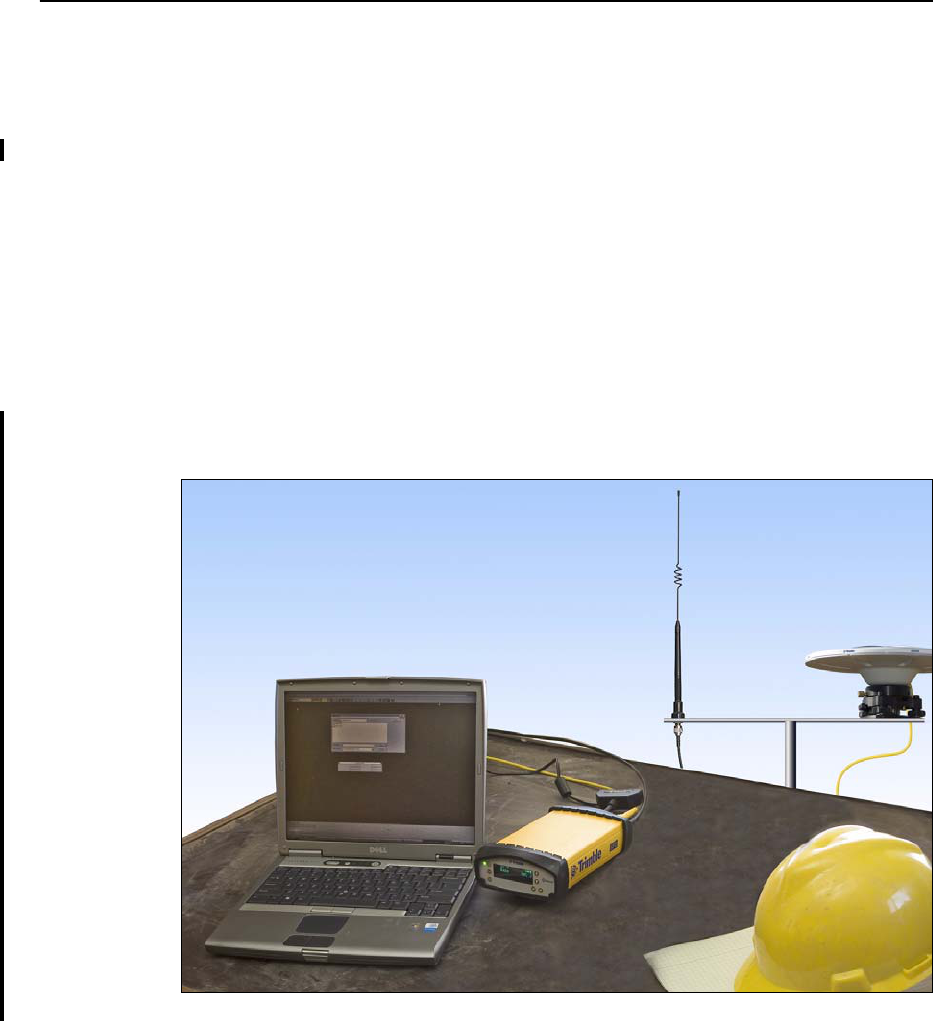
5 Setting up the Receiver
48 SPSx50 Modular GPS Receiver User Guide
and the weather. The GPS and radio antennas are normally mounted on a permanent
structure on the roof of the building, where they are high and clear from obstructions
and where the radio antenna can provide the maximum range of operation.
The GPS antenna used is most commonly the Zephyr Geodetic – Model 2 antenna,
which has a large ground plane that eliminates multipath, providing the best GPS
performance at the base location. The antennas are connected to the receiver by high
quality RF cables.
The receiver is connected to a permanent power supply (mains or generator power).
The internal battery of the receiver is always being charged, and acts as an
uninterruptible power supply if there is a power outage. In some cases, the receiver
may also be connected by an Ethernet cable to the Internet, so that it can be
monitored and configured from a remote location, and warn an administrator by
e-mail or text message if there is a change to the configuration. In these situations, the
receiver can transmit GPS RTK corrections to a remote radio or receiver over the
Internet for rebroadcast requirements without using repeaters.
Figure 5.1 SPSx50 receiver permanent installation
Setting up a Base Station for Daily Site Use: T-Bar
For construction applications where a daily setup and takedown of equipment is
required for security reasons, Trimble recommends that you use a T-Bar setup.
The T-Bar consists of a post mounted in concrete (so it cannot move), which has a
solid metal Bar T piece mounted to it to provide lateral separation between the GPS
antenna and radio antenna. The T piece of the T-Bar will have vertical rods at either
end, terminating in a 5/8 thread to which the antennas can be mounted. Trimble
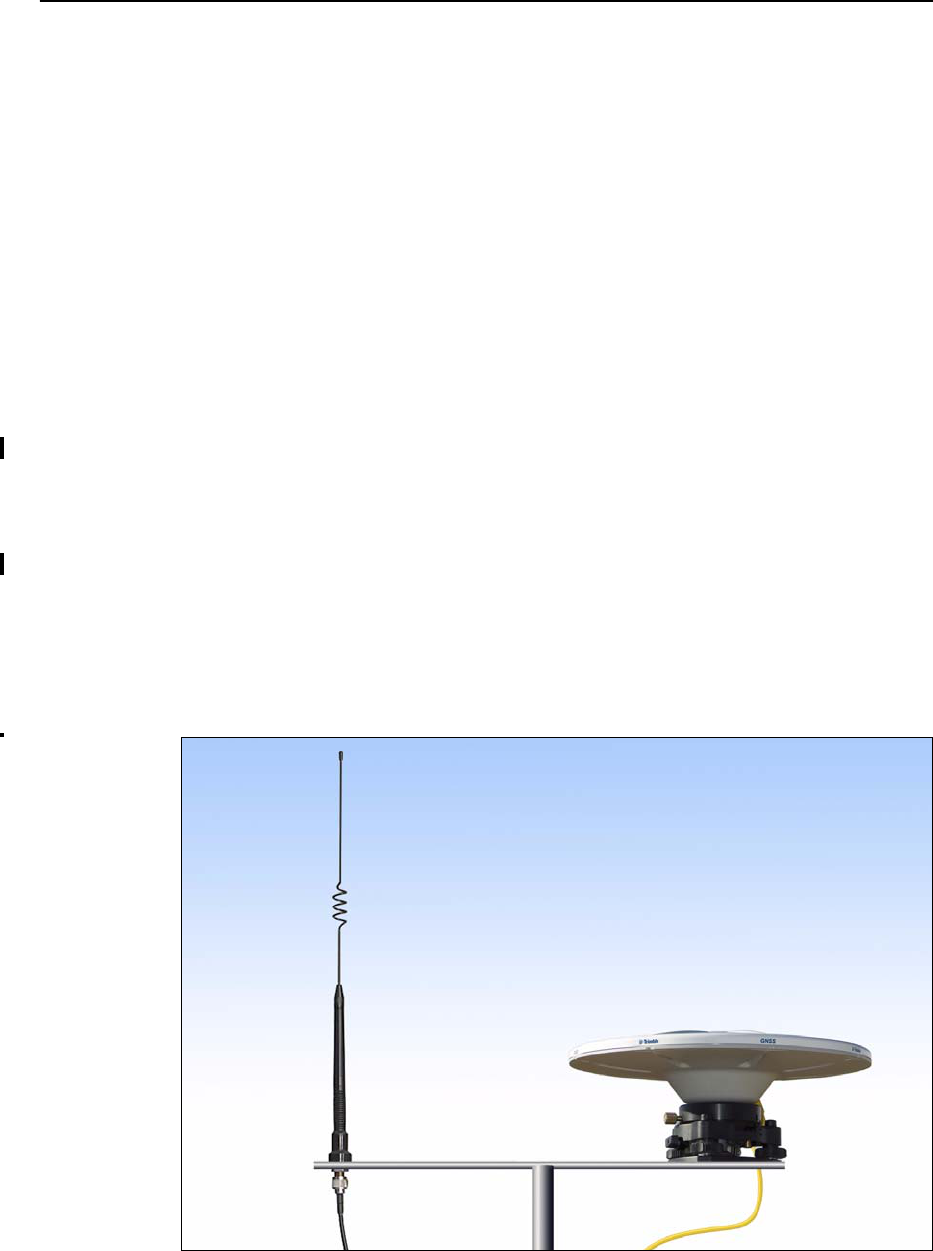
SPSx50 Modular GPS Receiver User Guide 49
Setting up the Receiver 5
recommends that each end is clearly marked GPS and Radio respectively, to ensure
that at each daily setup the GPS and Radio antennas are mounted at the same location.
Switching antennas by mistake introduces a position error in all resulting
measurements. The equipment required to fabricate a T-Bar can be purchased in any
reputable hardware store. Take care to ensure that the T-Bar cannot rotate after
construction. Rotation of the T-Bar can introduce a position error into all subsequent
measurements.
On the upright post, either mount a bracket to which the GPS receiver can be
mounted, or place a lock box with ventilation on the post, in which the GPS receiver
itself can be secured.
Each day, mount the GPS antenna on the GPS end of the T-Bar and the radio antenna
on the Radio end of the T-Bar. Connect the Radio and GPS Antenna to the receiver
using the appropriate cables. In these scenarios, the receiver will operate from its own
integrated battery or from an external 12 V battery through use of the 12 V crocodile
clips cable provided with the receiver. If AC power is available, this can be used,
however the heat generated by the charging process and the radio transmitter
increases the need for good ventilation around the receiver to dissipate the heat.
In these scenarios an SPSx80 smart GPS antenna is also often used, in which case the
receiver only needs to be mounted on the T-Bar and optionally connected to an
external battery or radio unit.
The benefit of the T-Bar setup is that it is easy to ensure that the base station is set up
daily in the exact same location each day in terms of position and height, that will
eliminate the errors typically associated with daily setup on a tripod (wrong antenna
heights, not setup over the point, setup in the wrong location etc.)
Figure 5.2 System set up on a T-bar

5 Setting up the Receiver
50 SPSx50 Modular GPS Receiver User Guide
Setting up a Mobile Base Station: Tripod and Fixed Height Tripod
For construction applications where you are repeatedly moving between jobsites, or
you are visiting a jobsite for the first time before a T-bar or similar setup can be
established, Trimble recommends that you use either a tripod and tribrach setup or a
fixed height tripod.
The fixed height tripod is quicker and easier to setup over a control point. In these
situations, you need to take great care to ensure that the GPS antenna is set up
accurately over the control point, and that the GPS antenna height is measured
accurately, in the right way (vertical or slope height) to the right location on the
antenna (base of antenna or to a specified location on the antenna). It is also more
important for operators using these types of setup to check in, at one or more known
locations, on starting the rover receiver to check for possible position or height errors
before starting work. Checking in at a known location is good practice and can avoid
costly errors caused by a bad setup.
The tripod and fixed height tripod method, typically does not give a significant height
clearance above the ground, and can result in reduced range of operation caused by
radio limitations.
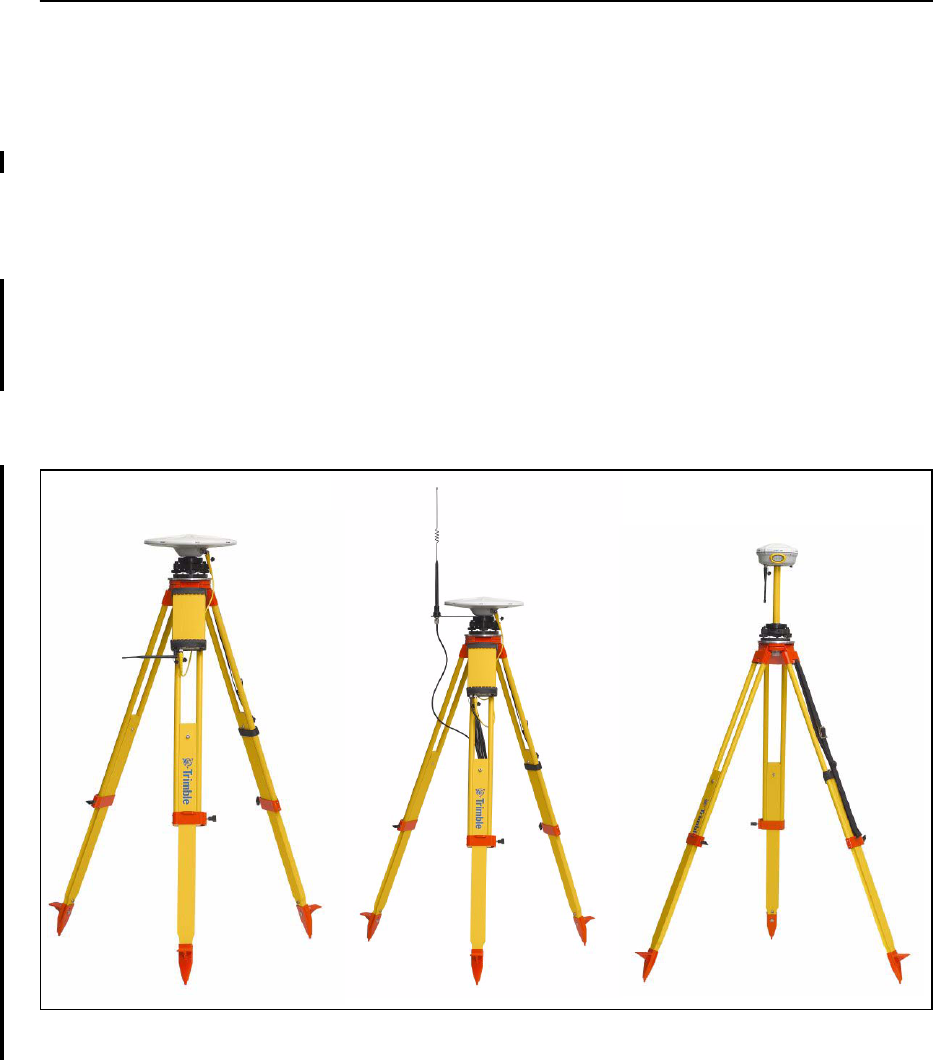
SPSx50 Modular GPS Receiver User Guide 51
Setting up the Receiver 5
Tripod Setup
In the tripod setup, the tripod is located over the control point, the tribrach and
tribrach adaptor is mounted on the tripod and centered over the point.
1. Mount the GPS antenna on the tribrach adaptor.
2. If you are using a SPSx80 smart GPS antenna, use the 25 cm spacer rod provided
with the SPSx80 base station accessory kit to allow the radio antenna in the
receiver to clear the head of the tripod.
3. Clip the GPS receiver to the tripod (SPSx50 Modular GPS receiver and SPS770
GPS receiver).
4. Connect the GPS antenna using the appropriate cable (SPSx50 Modular GPS
receiver and SPS770 GPS receiver).
5. If necessary, connect the GPS receiver to an external 12 V power supply using
the crocodile clip cable or the Trimble custom power pack.
Figure 5.3 Tripod and tribrach setup for the SPSx50 Modular GPS receiver and SPSx80 Smart GPS
antenna
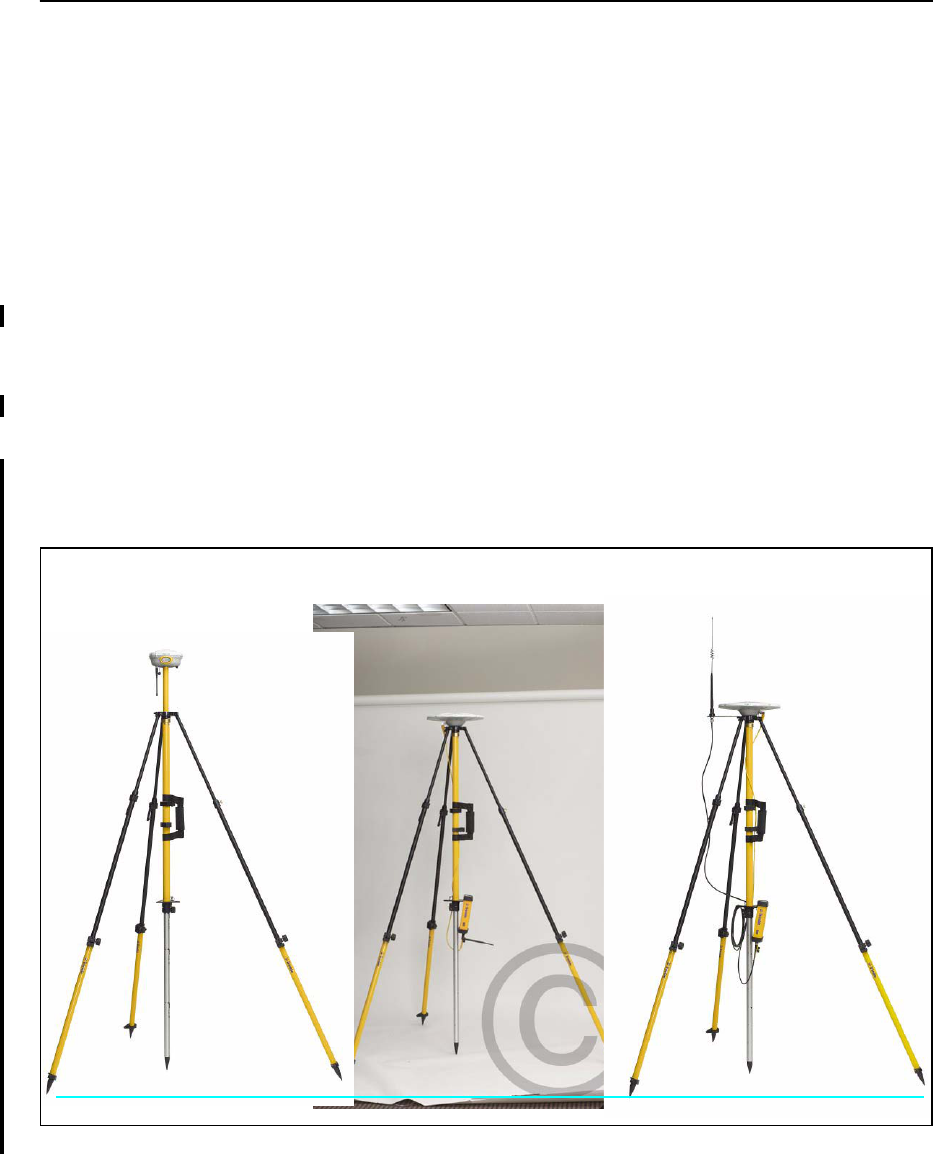
5 Setting up the Receiver
52 SPSx50 Modular GPS Receiver User Guide
Fixed Height Tripod Setup
Using a fixed height tripod, the setup is similar to that of the tripod setup, however the
setup is simplified by the central leg of the tripod, that is placed directly on the control
point. Provided the central leg is leveled accurately, the fixed height tripod is quick and
easy to set up, and provides an easy and accurate means of measuring the true
antenna height.
1. Set up the tripod over the control point.
2. Attach the GPS antenna to the head of the tripod
3. When using a high-gain external radio antenna, mount the radio antenna to the
radio antenna bracket, which is attached to the head of the tripod beneath the
GPS antenna. See Figure 5.4.
4. If you are using theSPSx50 Modular GPS receiver, you can hook it to the center
leg of the tripod using the tripod clip.
5. If you are using the SPSx80 Smart GPS antenna, you can mount the antenna
using the 25 cm spacer rod (supplied with the SPSx80 Base Station Accessory
kit) so that the radio antenna clears the head of the tripod.
Figure 5.4 Fixed height tripod setup for the SPSx50 Modular GPS receiver and SPSx80 Smart GPS antenna
x50 900 ext ant Fixed.jpgx50 450 Fixed - x50 9000048.jpgSPS880 450 Fixed.jpg

SPSx50 Modular GPS Receiver User Guide 53
Setting up the Receiver 5
Common ways to set up a rover receiver
This section describes how to set up a rover receiver in different ways depending on
the application. The components that make up a rover receiver are:
•GPS receiver
•GPS antenna
•Controller/Computer
•Rod mounting equipment including a rod, receiver bracket, and controller
bracket
•Vehicle mounting equipment including a suction cup and ball joint, extension
arm, controller bracket, magnetic antenna mount, and necessary cables.
•Backpack equipment including backpack and antenna-mounting rod
•Marine vessel mounting equipment including receiver bracket, cables, antenna,
and radio antenna brackets.
Setting up the rover receiver on a jobsite vehicle
CCAUTION – This solution is suited for off road use while operating a vehicle on a jobsite.
This setup is not recommended, or designed, for on road use while driving a vehicle at
speed in traffic.
To use the receiver as a vehicle-mounted rover receiver, set up the equipment as
follows:
1. Do one of the following depending on your receiver:
– For the SPSx50 or SPS770, mount the GPS antenna for the receiver on the
roof of the vehicle, using either a single magnetic mount or a 5/8 thread
attached to the roof bars.
– For the SPSx80, mount the receiver to the roof of the vehicle using either a
triple magnetic mount or a 5/8 thread bolt attached to the roof bars.
2. For the SPSx50 or SPS770, run the GPS antenna cable for the receiver into the
vehicle either through a rubber grommet in the roof, or through the passenger
door window, which needs to be left slightly open during operation.
3. For the SPSx50 or SPS770, place and secure the GPS receiver in a convenient
location in the vehicle.
The GPS receiver can be controlled via the controller connected using Bluetooth
wireless technology (cable free) (SPSx50 or SPSx80) or a cable connected to a
port on the receiver (SPS770).

5 Setting up the Receiver
54 SPSx50 Modular GPS Receiver User Guide
The receiver needs to be accessed only to turn it on at the start of each
measurement session. It may be more convenient if the SPSx50 is placed in a
location where the vehicle operator can see the keypad and display, to monitor
receiver status and to configure settings as required. Most receiver capability
can be controlled using the SCS900 controller software.
4. Attach the suction cup to either the front windscreen, dashboard, or other
convenient location in the vehicle making sure that it does not obstruct the
drivers view.
5. Attach the RAM extension arm to the suction cup, and the controller bracket to
the RAM extension arm.
6. Lock the controller into the controller bracket, and adjust the bracket until the
controller is in the most convenient location. Make sure that the controller does
not restrict visibility through the front windscreen during vehicle use.
7. Lock the brackets so that the controller is held securely. If required, connect
either the GPS receiver or the controller to in vehicle power supplies as needed.
Figure 5.5
S antenna in a magmount on vehicle roof
n
troller in suction cup mount in vehicle.
b
/Nick providing.
19 Dec. Needing mockup/instructions from product staff
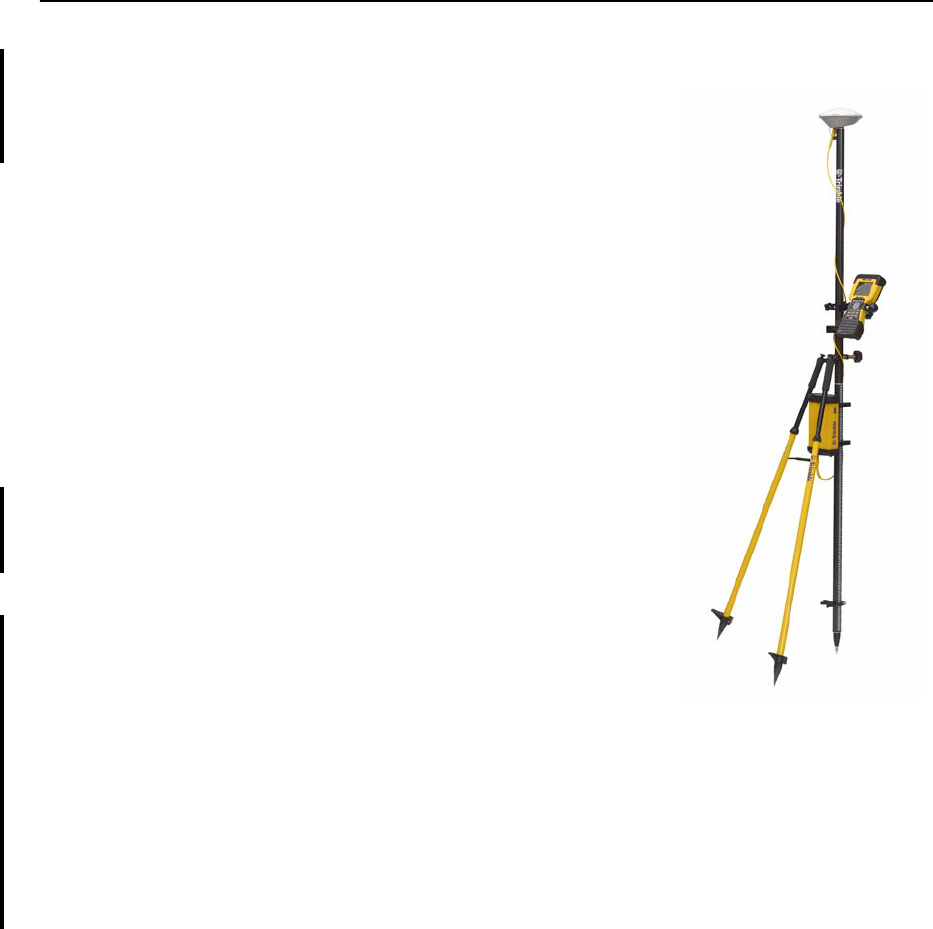
SPSx50 Modular GPS Receiver User Guide 55
Setting up the Receiver 5
Setting up the rover receiver on a rod
For rod-based operation, mount the SPSx50 Modular
GPS receiver or SPS770 Modular GPS receiver using the
two rod brackets as follows:
1. Mount the two rod brackets on the rod.
2. Tighten the uppermost of the two making sure
that it is at a convienent height for the receiver.
3. Place the receiver into the slot in the rod bracket,
and secure it with the tripod clip.
4. Lower the lower of the two rod brackets over the
second tripod clip on the receiver, and tighten
onto the rod. The receiver is held in place
between the two brackets.
5. Mount the controller into the controller bracket
as shown <?>.
6. Attach the GPS antenna to the top of the rod
using the 5/8 thread.
7. Connect the receiver to the GPS antenna using
the antenna cable.
For rod-based operation, mount the SPSx80 Smart GPS
antenna as follows:
1. Mount the receiver to the top of the rod using the 5/8-11 thread in the base of
the SPSx80.
2. Mount the controller into the controller bracket as shown <?>.
3. The SPSx80 and controller will communicate through Bluetooth wireless
technology. However, if a cable is required, connect the cable between the
controller and receiver (see Figure 5.6 through Figure 5.8). <<I NEED TO
KNOW WHICH CABLES SO VANESSA CAN ILLUSTRATE CORRECTLY>>
19 Dec. With Vanessa.
SPSx50 Rover ISO.jpg
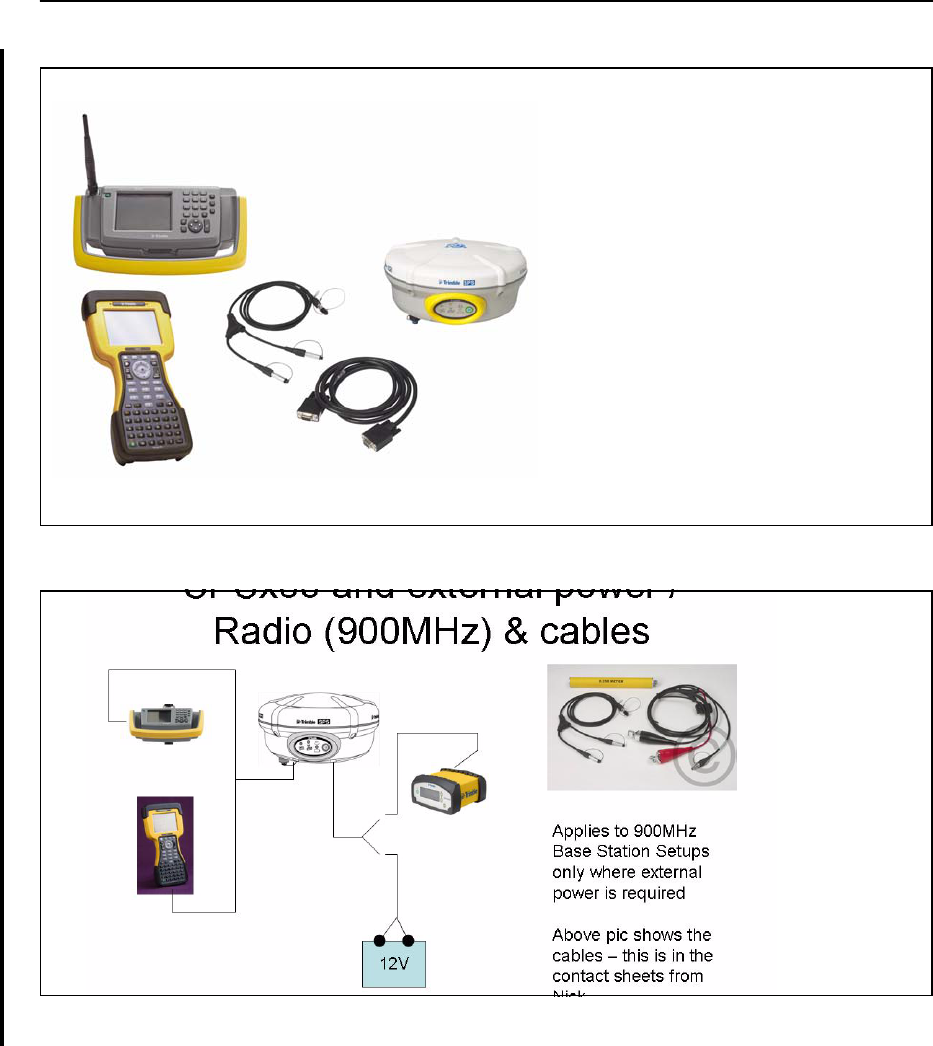
5 Setting up the Receiver
56 SPSx50 Modular GPS Receiver User Guide
Figure 5.6 Connections for a rover SPSx80 setup, a TSC2 or TCU controller, and a 450 Mhz base station
Figure 5.7 Cabled connections for a SPSx80 setup, a TSC2 or TCU controller, and a 900 Mhz base station
(with external power)
20 Dec. With Vanessa
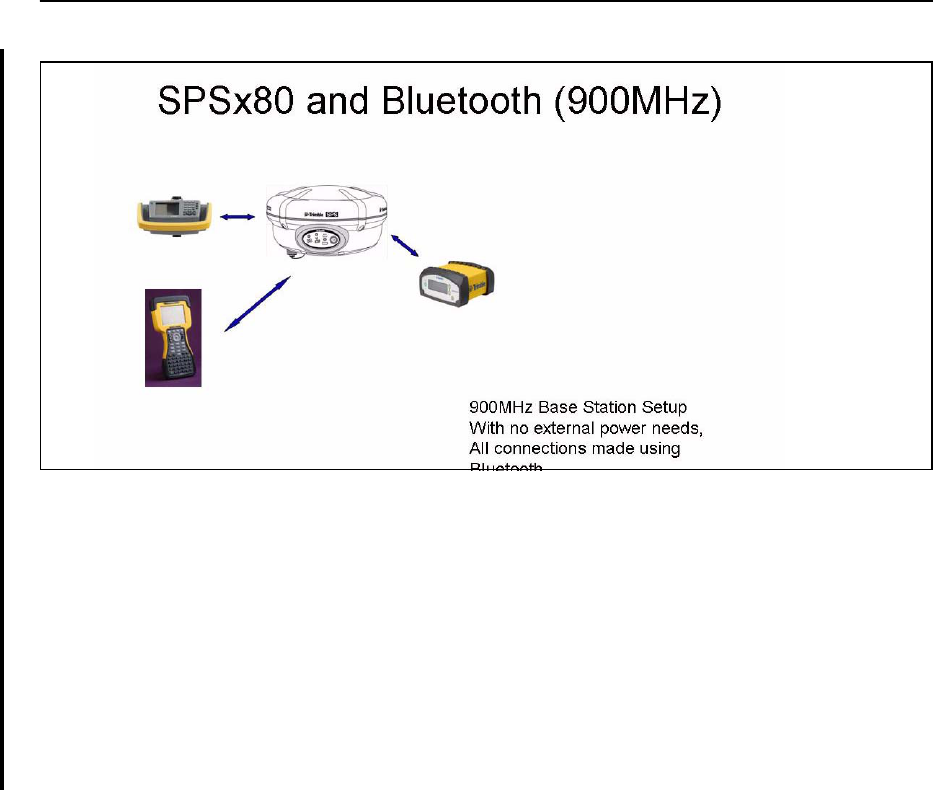
SPSx50 Modular GPS Receiver User Guide 57
Setting up the Receiver 5
Figure 5.8 Cable-free connections using Bluetooth wireless technology for a rover SPSx80 setup, a TSC2
or TCU controller, and a 900 Mhz base station (with no external power)
Setting up a rover receiver on a belt or in a backpack
The receiver can be work on a belt or carried in a backpack to eliminate weight from
the pole as needed. When you wear the receiver on a belt, ensure that the display is
always visible so that you can easily check the status of the receiver. If you carry the
receiver in a backpack, you should use an external radio antenna mount to allow for
optimal radio signal reception. If you use a low gain antenna mounted directly on the
receiver in a backpack, it may affect the radio signal reception thereby reducing the
likelihood of obtaining an RTK Fixed solution.
20 Dec. With Vanessa

5 Setting up the Receiver
58 SPSx50 Modular GPS Receiver User Guide
Setting up a pair of SPSx50 GPS receivers to provide heading
The SPS550H receiver is permanently in Heading mode and, when combined with a
suitable Trimble receiver, provides GPS heading. Other SPSx50 GPS receivers can be
used for heading only if they can operate in Heading mode (see Configuring the
receiver pair, page 64).
The SPS550H is a dual-frequency GPS receiver with a dual-frequency antenna, but it
does not operate as a stand-alone DGPS receiver. To compute a true north heading and
to be capable of positioning, the receiver requires an output message from another
SPSx50 receiver. To determine the precise vector between two moving objects, pair the
SPS550H heading add-on with any one of the following SPSx50 receivers:
•SPS550
•SPS750 Max
•SPS850
Connect the antenna on the SPS550H to the other SPSx50 receiver to determine the
precise GPS heading between the two antennas. The SPS550H GPS receiver displays
the heading on the two-line display, and outputs the heading data in NMEA or binary
format.
BTip – To create a single, compact GPS position and heading unit, use the mounting frame
provided to stack the SPS550H GPS receiver on top of another SPSx50 GPS receiver. See
below. Use the Marine Heading Cable (P/N 57169) provided.
The Moving Baseline RTK positioning technique
In most RTK applications, the reference receiver remains stationary at a known
location and the rover receiver can move. However, Moving Baseline RTK is an RTK
positioning technique in which both reference and rover receivers can move about.
Moving Baseline RTK is useful for GPS applications that require vessel orientation.
Figure 5.9 Vessel heading from Moving Baseline RTK
to be done
Vessel heading
Antenna
Antenna
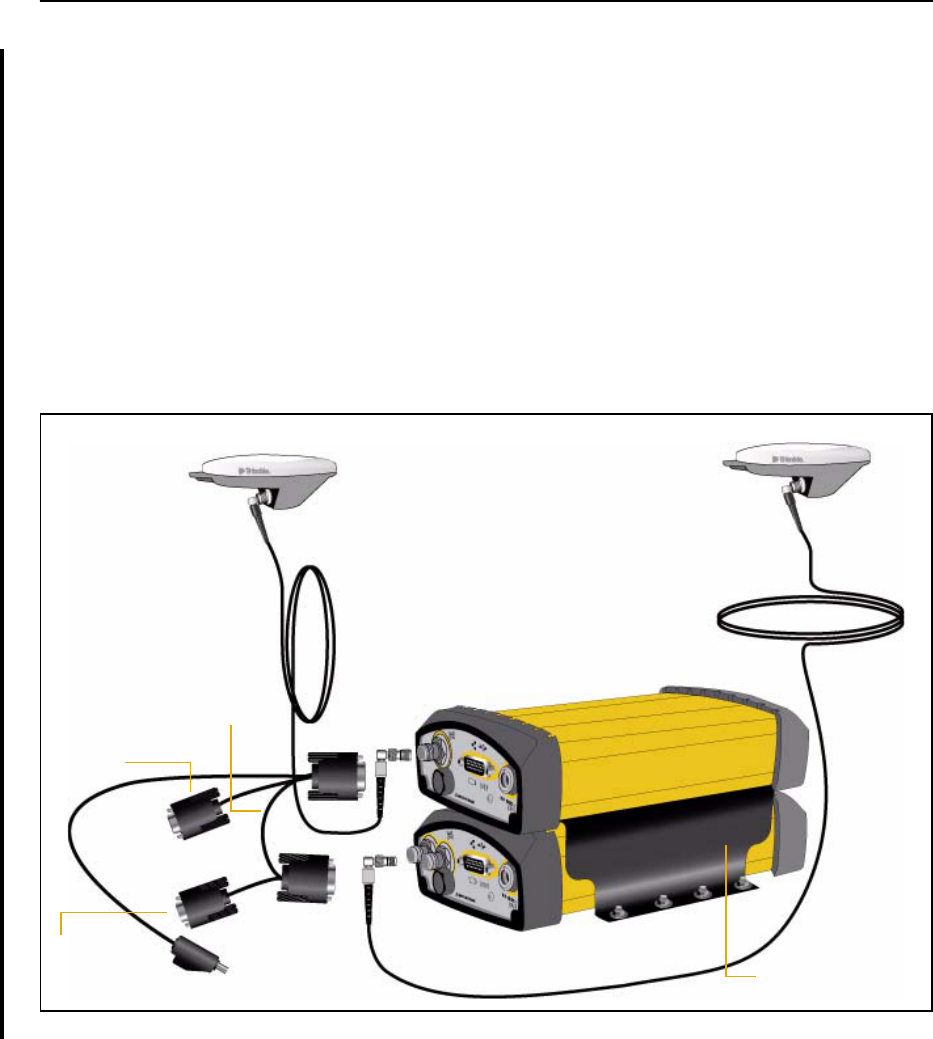
SPSx50 Modular GPS Receiver User Guide 59
Setting up the Receiver 5
With Moving Baseline RTK, the reference receiver broadcasts Compact Measurement
Record (CMR) data every epoch, while the rover receiver performs a synchronized
baseline solution at 10 Hz. The resultant baseline solution has centimeter-level
accuracy. To increase the accuracy of the absolute location of the two antennas, the
Moving Reference receiver can use differential corrections from a static source, such as
a shore-based reference station.
Mounting a pair of SPSx50 GPS receivers
To obtain a position and heading solution, you need to connect two SPSx50 receivers
to make one compact unit. A mounting bracket and interconnecting cable is supplied
with the SPS550H receiver. Set up the receivers, antennas, and cables as shown in
Figure 5.2.
Figure 5.10 Installation setup for the SPS550H with another SPSx50 receiver for position and heading
Dual-frequency rover antenna Dual-frequency rover antenna
SPS550H
SPSx50
Antenna cable
Marine heading
cable (P/N 57169)
Serial Port 2
SPS550H
Serial Port 2
SPSx50 DC power Mounting bracket
(P/N 56830-00)
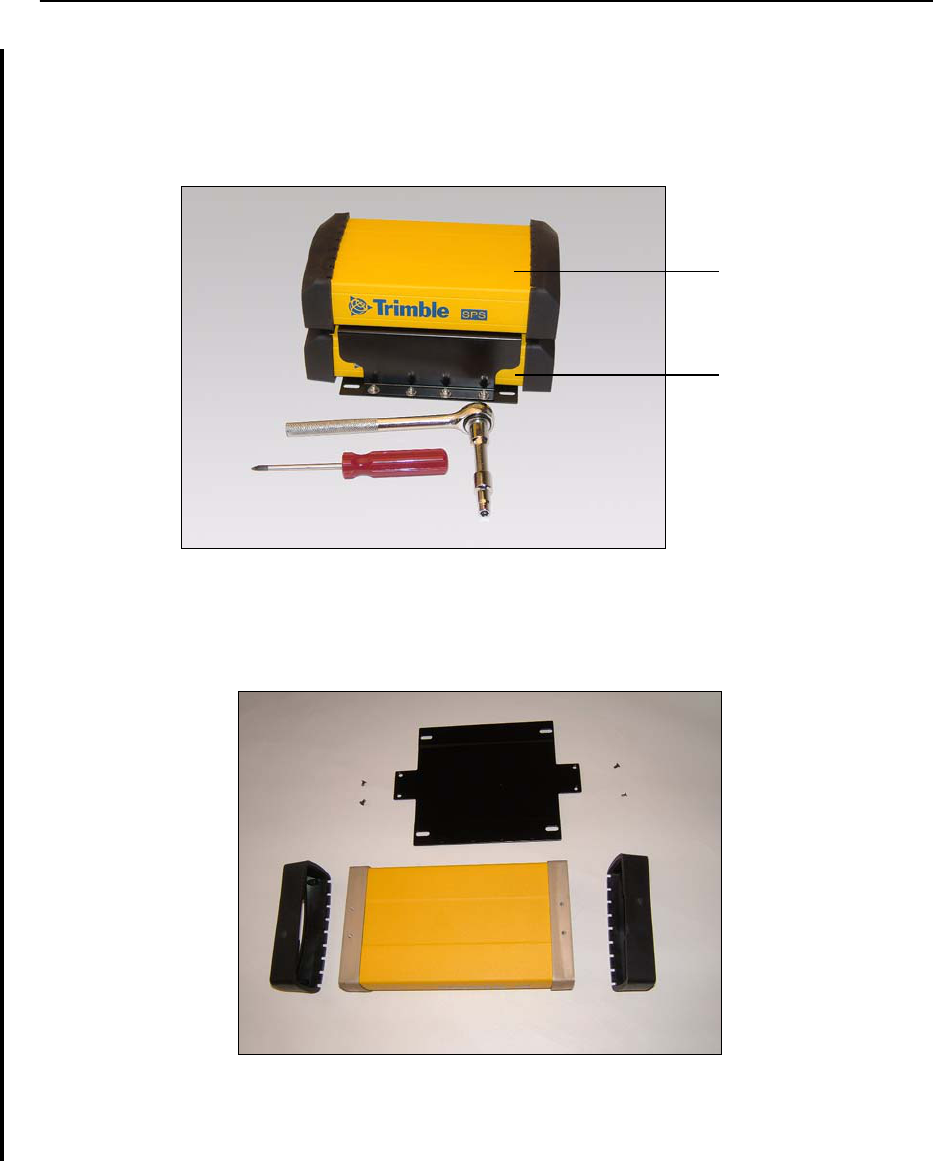
5 Setting up the Receiver
60 SPSx50 Modular GPS Receiver User Guide
Assembling the receivers
Figure 5.11 shows a SPS550 and a SPS550H set up to provide a Heading solution. To
assemble the receivers you need a Phillips head #1 screwdriver and a 1/4" socket set or
wrench (spanner).
Figure 5.11 Completed assembly with SPS550H GPS receiver on top
To assemble the receivers using the mounting frame that is provided:
1. Invert the SPSx50 GPS receiver and remove the rubber endcaps.
2. Prepare the flat black plate and the four Posi screws. (These are part of the
mounting frame.)
3. Position the black plate on the SPSx50 GPS receiver.
SPS550H GPS receiver
Other SPSx50
GPS receiver
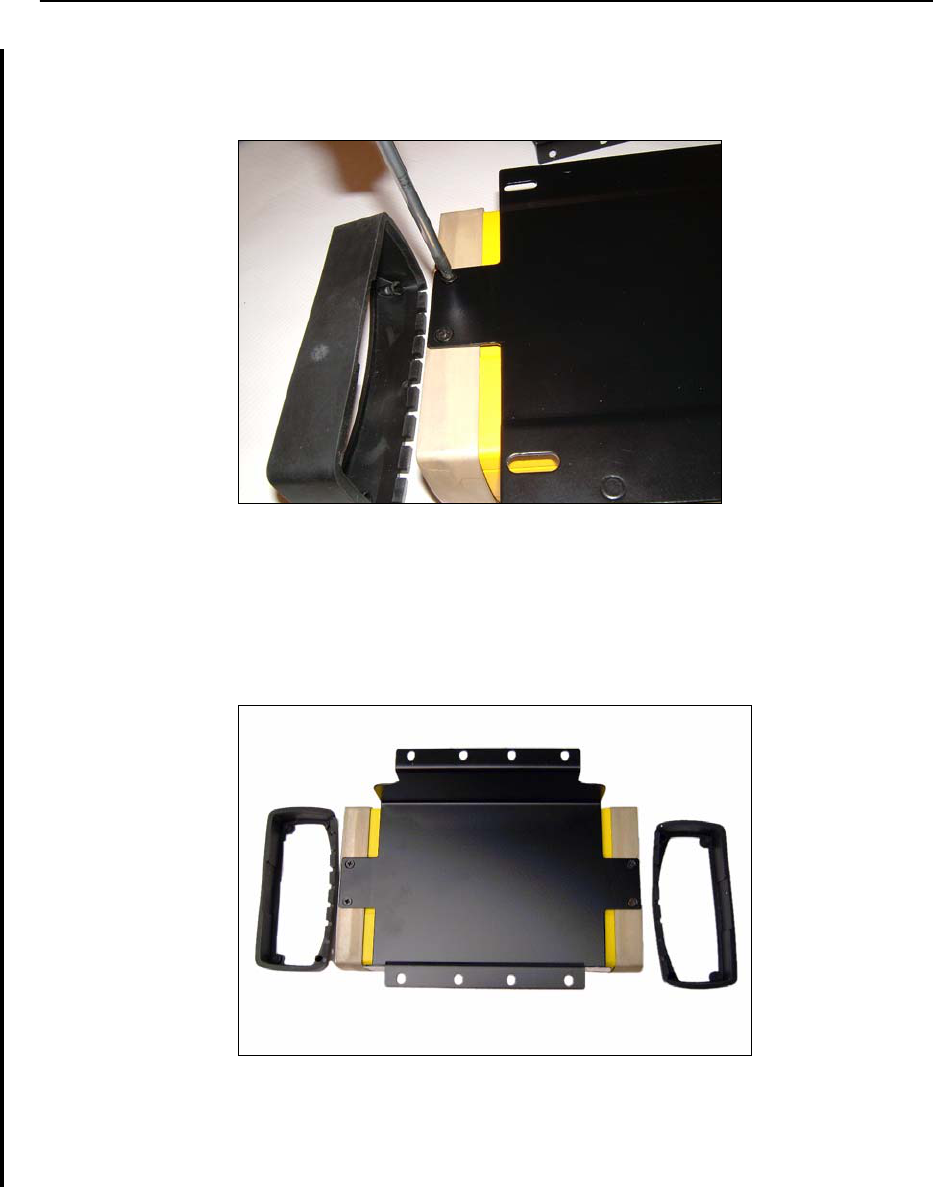
SPSx50 Modular GPS Receiver User Guide 61
Setting up the Receiver 5
4. Use the four Posi screws to secure the plate to the receiver. (Secure two screws
at each end.) The black plate is now attached to the bottom of the SPSx50 GPS
receiver.
5. Replace the rubber endcaps.
6. Invert the SPSx50 receiver again. This returns the receiver to its normal
orientation.
7. Set aside the SPSx50 receiver.
8. Invert the SPS550H receiver and remove the rubber endcaps.
9. Position the black cradle on the SPS550H GPS receiver. (The black cradle is part
of the mounting frame.)
10. Use the four Posi screws to attach the black cradle to the receiver. The black
cradle is now attached to the bottom of the SPS550H.
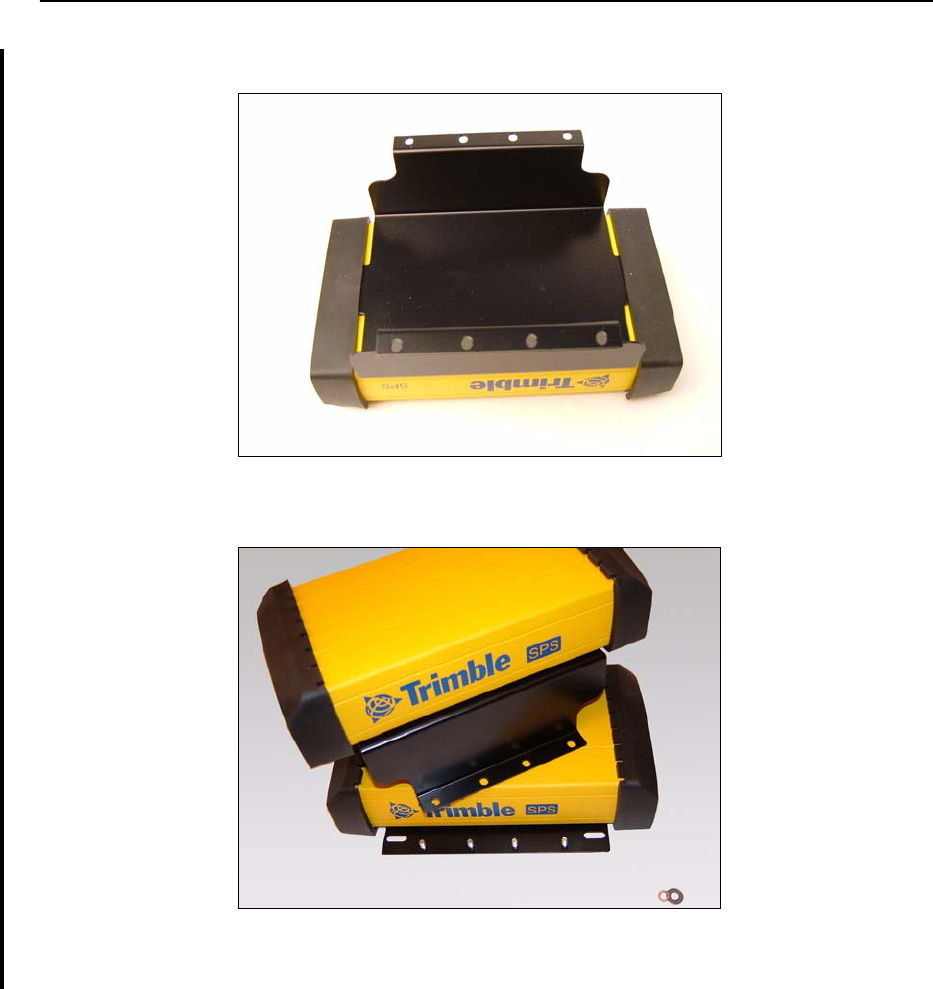
5 Setting up the Receiver
62 SPSx50 Modular GPS Receiver User Guide
11. Replace the rubber endcaps.
12. Place the black cradle on the black base plate. This places the SPS550H GPS
receiver on top of the SPSx50 GPS receiver..
13. Make sure that the display is facing in the same direction on both receivers.
14. Prepare the eight nuts, spring washers, and flat washers.
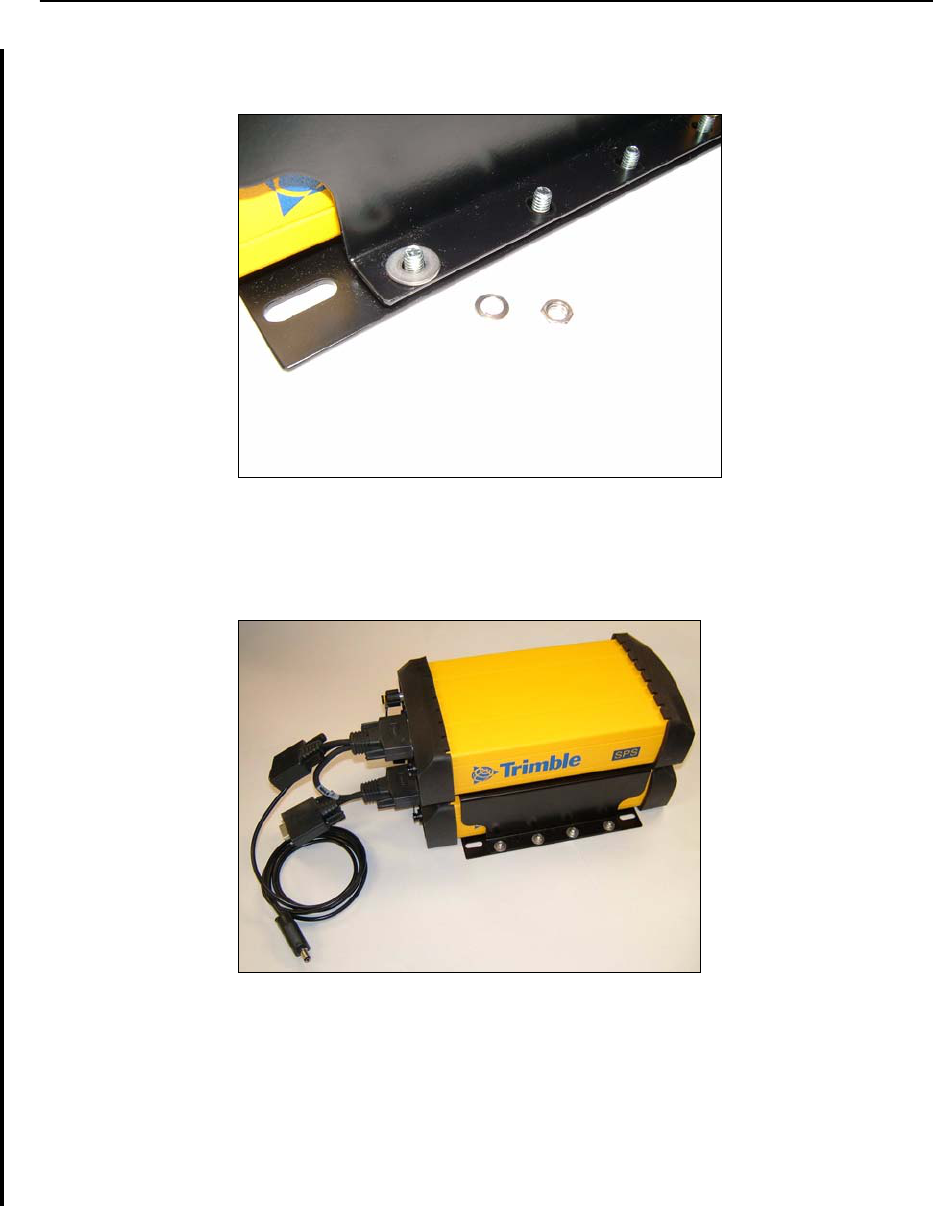
SPSx50 Modular GPS Receiver User Guide 63
Setting up the Receiver 5
15. Insert the first bolt. Attach the flat washer, the spring washer, and finally the nut
and then tighten firmly. Secure all eight bolts in this way..
16. Attach one connector from the Marine Heading Cable (P/N 57169) to the 26-pin
connector on the rear of the SPS550H GPS receiver. Attach the other connector
from the cable to the 26-pin connector on the rear of the SPSx50 receiver. The
cable can be connected either way around.
The cable connects the two GPS receivers so that the Heading solution is
available. The DC power lead on the cable is used to supply power to both
receivers in the stack. The two DB9 female connectors on the cable access serial
port 2 on each receiver.
Installing the receiver
Select a location at which all of the following conditions are met:
•the receiver is not exposed to temperature extremes

5 Setting up the Receiver
64 SPSx50 Modular GPS Receiver User Guide
•the receiver is not exposed to moisture extremes (such as rain, snow, water
blasters, or wash systems)
•the receiver is protected from mechanical damage
•you can connect and disconnect cables without placing undue stress on them
Mounting the antennas
It is critical that you install each antenna at the correct location. Poor or incorrect
placement can influence accuracy and reliability.
Ideally, mount the two antennas as far apart as possible and at about the same height
on the structure. Mount the antennas fore and aft along the vessel centerline or on a
line that is at a known orientation to the centerline. Always mount an antenna at a
location that ensures a good view of the sky.
Follow these guidelines to select the antenna location:
•Choose an area with a clear view of the sky. The antenna must be above any
metallic objects.
•Do not mount the antenna close to stays, electrical cables, metal masts, or other
antennas.
•Do not mount the antenna near a transmitting antenna, a radar array, or near
satellite communication equipment.
•Avoid areas with high vibration, excessive heat, electrical interference, and
strong magnetic fields.
Use a 5/8" stainless steel bolt to mount each of the antennas. There is a threaded bolt
hole in the base of the antenna.
Configuring the receiver pair
One of the receivers must be nominated as a Heading unit. The other receiver is
nominated as a Moving Base unit. For this configuration to work, you must use the
Marine heading cable (P/N 57169).
To set up the Heading unit:
1. From the Home screen press <enter><enter>. The Mode screen appears.
2. Select Heading mode. The SPSx50 display shows two extra settings for heading:
–Heading Adjustment. Enter a positive value in decimal degrees. The value is
applied to the raw heading value before it is output in the NMEA HDT
message or displayed on the front panel of the receiver. This value is used
when the two antennas are not mounted parallel to the vessel axis.

SPSx50 Modular GPS Receiver User Guide 65
Setting up the Receiver 5
–Minimum Heading Solution. Enter the minimum requirement for the GPS
solution that will provide the heading value. The default of RTK Fixed
provides the highest precision, but in conditions of extreme multipath or
obstruction, an RTK Fixed solution may not be continuously available. In
such conditions, select RTK Float if a lower precision is acceptable.
To set up the Moving Base unit:
1. From the Home screen press <enter><enter>. The Mode screen appears.
2. Select Moving Base mode.
Interfacing using the NMEA protocol
The SPS550H GPS receiver can output messages such as NMEA HDT for heading, and
NMEA GGA for position. The SPS550H always reports the solution status of the
moving baseline solution that is being used to compute the heading. For example,
Modem (serial port 2) on SPS750, which is typically RTK Fixed Integer. However, if the
external computer must know the exact quality of the position, you can use the NMEA
output from the base receiver. The base receiver reports the solution status of the
position, for example, Fixed Integer, Floating, orDGPS.

5 Setting up the Receiver
66 SPSx50 Modular GPS Receiver User Guide

CHAPTER
6
SPSx50 Modular GPS Receiver User Guide 67
Configuring the SPSx50 Modular GPS
Receiver Using the Keypad and
Display 6
In this chapter:
QHome screen
QStatus screens
QConfiguring the SPSx50 as a base
receiver
QConfiguring the SPSx50 as a rover
receiver
QConfiguring system settings

6 Configuring the SPSx50 Modular GPS Receiver Using the Keypad and Display
68 SPSx50 Modular GPS Receiver User Guide
Home screen
The Home screen is the main screen displayed on the SPSx50 receiver. If the receiver is
displaying another screen and is left idle for 60 seconds, you are returned to this
screen. The Home screen shows the following information:
•Number of satellites being tracked
•Internal battery power remaining
•Current mode configuration
•Internal radio activity
•Internal radio channel or network
Status screens
The SPSx50 GPS receivers have several view-only status screens that allow you to
review the current settings of the receiver. The status screens provide the following
information:
•Position solution
•CMR and RTCM IDs
•Base name and code
•Latitude, longitude, and height
•Antenna height
•Horizontal and vertical precision
•Receiver firmware version
•Receiver serial number
•Receiver IP address
To access these screens from the Home screen, press Up or Down.
Configuring the SPSx50 as a base receiver
To set up the SPSx50 base receiver use the Autobase feature, the Trimble SCS900 Site
Controller software, or the receiver keypad.
The Autobase feature automatically configures the receiver settings for you; there is no
need to use the keypad. The receiver obtains a position and outputs RTK corrections
on the internal radio (if available) or on the LEMO port. See Chapter 7, Autobase
Feature.
The receiver is configured step by step to ensure that all appropriate settings are
configured. To move between steps in the configuration process, press Enter.

SPSx50 Modular GPS Receiver User Guide 69
Configuring the SPSx50 Modular GPS Receiver Using the Keypad and Display 6
Configuring the receiver
1. In the Home screen, press Enter. Use the Operation Mode screen to configure
system settings, mode settings, or to view the SV (satellite) status. Mode Settings
is the default setting.
2. Press Enter. Use the Mode screen to select whether the receiver will operate as a
base or rover. Base is the default setting.
3. Press Enter. Use the Base Station screen to select whether the receiver is going to
use a “Here” position or if the current coordinates in the receiver will be
changed.
4. Press Right. When Edit Current begins to flash, the receiver is in Edit mode and
you can change the current setting.
5. Press Down. The setting changes to New Base (Here).
6. Press Enter to accept the change.
7. Press Enter again. The Base Name screen appears. See next.
Changing the name and description of the base station
In the Base Name screen:
1. Press Right. When the first character of the base name begins to flash, the
receiver is in Edit mode and you can change the current setting.
2. Press Up or Down to change the value of the character.
3. Press Right to move the cursor to the next character.
4. Repeat Step 2 through Step 3 to enter the name of the base station. The name
can be up to 16 characters. Press Enter to accept the change.
5. Press Enter again. Use the Base Code screen to change the code (description) for
the base station.
6. Press Right. When the first character of the base code begins to flash, the
receiver is in Edit mode and you can change the current setting.
7. Press Up or Down to change the value of the character.
8. Press Right to move the cursor to the next character.
9. Repeat Step 7 through Step 8 to enter the code of the base station. The code can
be up to 16 characters.
10. Press Enter to accept the change.
11. Press Enter again. The Base Latitude screen appears. See next.

6 Configuring the SPSx50 Modular GPS Receiver Using the Keypad and Display
70 SPSx50 Modular GPS Receiver User Guide
Setting the reference latitude, longitude, and height of the base station
In the Base Latitude screen:
1. The base was set up with a “Here” position, so press Enter.
2. The Base Longitude screen is used to change the reference longitude of the base
station. The base was set up with a “Here” position, so press Enter.
3. The Point Height screen is used to change the reference height of the base
station. The base was set up with a “Here” position, so press Enter.
4. Use the Antenna Type screen to select the type of antenna used with the receiver.
Press Right. When the antenna name begins to flash, the receiver is in Edit
mode and you can select an antenna.
5. Press Down to scroll through the antenna models.
6. Once the correct antenna name is displayed, press Enter to accept the change.
7. Press Enter again. The Measured To screen appears. See next.
Measuring and changing the antenna height
In the Measured To screen:
1. Press Right. When the antenna measurement method begins to flash, the
receiver is in Edit mode and you can select an antenna measurement method.
2. Press Down to scroll through the measurement methods. Once the correct
measurement method appears, press Enter to accept the change.
3. Press Enter.
4. Use the Antenna Height screen to change the height of the antenna. Press Enter.
When the first character of the antenna height begins to flash, the receiver is in
Edit mode and you can change the antenna height.
5. Press Up or Down to change the value of the character.
6. Press Right to move the cursor to the next character.
7. Repeat Step 5 through Step 6 to enter the height of the antenna.
8. Press Enter to accept the change.
9. Press Enter again. The Output screen appears. See next.
Outputting corrections
In the Output screen :
1. Press Right to enter Edit mode for the port.
2. Press Up or Down to change which port will be used to output corrections.
3. Press Enter to accept the change.
4. Press Down to move the cursor to the Format field.

SPSx50 Modular GPS Receiver User Guide 71
Configuring the SPSx50 Modular GPS Receiver Using the Keypad and Display 6
5. Press Right to enter Edit mode for the format.
6. Press Up or Down to change which correction message will be output on the
port.
7. Press Enter to accept the change.
8. Press Enter again.
9. Use the NMEA screen to set up NMEA outputs from the receiver. Press Enter to
accept the default of no NMEA messages.
10. Use the GSOF screen to set up GSOF outputs from the receiver. Press Enter to
accept the default of no GSOF messages.
11. Use the RT17 screen to set up RT17 outputs from the receiver. Press Enter to
accept the default of no RT17 messages. The Home screen appears and the base
setup is complete.
Configuring the SPSx50 as a rover receiver
You can use the Trimble SCS900 Site Controller software or the receiver keypad to set
up the SPSx50 base receiver.
The receiver is configured step by step to ensure that all appropriate settings are
configured. To move between steps in the configuration process, press Enter.
Configuring the receiver
1. In the Home screen, press Enter. Use the Operation Mode screen to configure
system settings, mode settings, or to view the SV (satellite) status. Mode Settings
is the default setting.
2. Press Enter. Use the Mode screen to select whether the receiver will operate as a
base or rover.
3. Press Right. When the mode begins to flash, the receiver is in Edit mode and
you can change this setting.
4. Press Down to change to Rover.
5. Press Enter to accept the change.
6. Press Enter again to move to the next screen. <<screen name? provides a neat
link>>See next.
Changing the elevation mask and RTK mode
1. Press Right . When the value for the current elevation mask begins to flash, the
receiver is in Edit mode and you can change the setting.
2. Press Down to change the elevation mask to the required value.

6 Configuring the SPSx50 Modular GPS Receiver Using the Keypad and Display
72 SPSx50 Modular GPS Receiver User Guide
Note – Trimble recommends that you do not set the elevation mask to a value lower than
10 degrees.
3. Press Enter to accept the change.
4. Press Down.
5. In the Mode field, press Right. When the current mode begins to flash, the
receiver is in Edit mode and you can change this setting.
6. Press Down to change the desired RTK mode of the receiver.
7. Press Enter to accept the change.
8. Press Enter again. The Antenna Type screen appears. See next.
Selecting the antenna
In the Antenna Type screen:
1. Press Right. When the antenna name begins to flash, the receiver is in Edit
mode and you can select the type of antenna that is to be used with the receiver.
2. Press Down to scroll through the antenna models.
3. Once the correct antenna name is displayed, press Enter to accept the change.
4. Press Enter again. The NMEA screen appears. See next.
Outputting corrections
In the NMEA screen, set up outputs from the receiver:
1. Press Enter to accept the default (No NMEA messages). Use the GSOF screen to
set up GSOF outputs from the receiver.
2. Press Enter to accept the default of no GSOF messages. Use the RT17 screen to
set up RT17 outputs from the receiver.
3. Press Enter to accept the default of no RT17 messages. The Home screen
appears, and the base setup is complete.
Configuring system settings
You can use the keypad and display of the SPSx50 receiver to configure the following
receiver settings:
•Display language
•Display and input units
•Baud rate, parity, data bits, and stop bits for serial ports
•Display power saver
•Autobase warning

SPSx50 Modular GPS Receiver User Guide 73
Configuring the SPSx50 Modular GPS Receiver Using the Keypad and Display 6
To access these receiver settings:
1. In the Home screen, press Enter. Use the Operation Mode screen to configure
system settings or mode settings, and to view the SV (satellite) status. Mode
Settings is the default setting.
2. Press Right. When the operation mode begins to flash, the receiver is in Edit
mode and you can change this setting.
3. Press Down to change to System Setup.
4. Press Enter to accept the change.
5. Press Enter again.
6. Use the Display Language screen, if necessary, to change the language. Choose
English, French, German, Italian, or Spanish. Press Enter to accept the change.
7. Press Enter again. Use the Display and Input Units screen, if necessary, to change
the units to Meters or Feet.
8. Press Enter to accept the change.
9. Press Enter again. Use the Port Settings screen, if necessary, to change the port.
10. Press Enter to accept the change.
11. Press Enter again. Use the Screen Pwr Savr screen to choose whether On, Off, or
Auto. If you use the Auto setting, 60 seconds. This setting turns the screen off
after a specified period of inactivity. The Power LED remain lit so you can tell if
the receiver is on or off. If an error message appears, the screen comes back on.
Press Enter to accept the change and then press Enter again to move to the next
screen.
12. The Autobase warning screen appears. <<when I used the x50, this screen didn’t
appear? Dianne> See Chapter 7, Autobase Feature.
13. Press Enter to accept the change.
14. Press Enter again. When the Home screen appears, the system setup is
complete.

6 Configuring the SPSx50 Modular GPS Receiver Using the Keypad and Display
74 SPSx50 Modular GPS Receiver User Guide

CHAPTER
7
SPSx50 Modular GPS Receiver User Guide 75
Configuring the Receiver Settings 7
In this chapter:
QUsing the SCS900 Site Controller
software to configure the base
station, rover, and the radios
QConfiguring the receiver to log
data for postprocessing
QConfiguring Ethernet Settings
QConfiguring the SPSx50 Receiver
Using a Web Browser
You can configure the SPS GPS receiver family in
a variety of ways. This appendix describes the
different configuration methods, and explains
when and why each method is used.
The SCS900 Site Controller software is likely to be
your main tool to set up and operate the receiver
on a daily basis. For more information, refer to
the Trimble SCS900 Site Controller Software
Getting Started Guide or the Trimble SCS900 Site
Controller Software Office Guide.
The external software detailed in this appendix is
primarily used to update the receiver firmware
and to configure upgrades or radio channels. All
necessary field configurations are handled
through the SCS900 software running on a
TSC2™ or TCU controller.
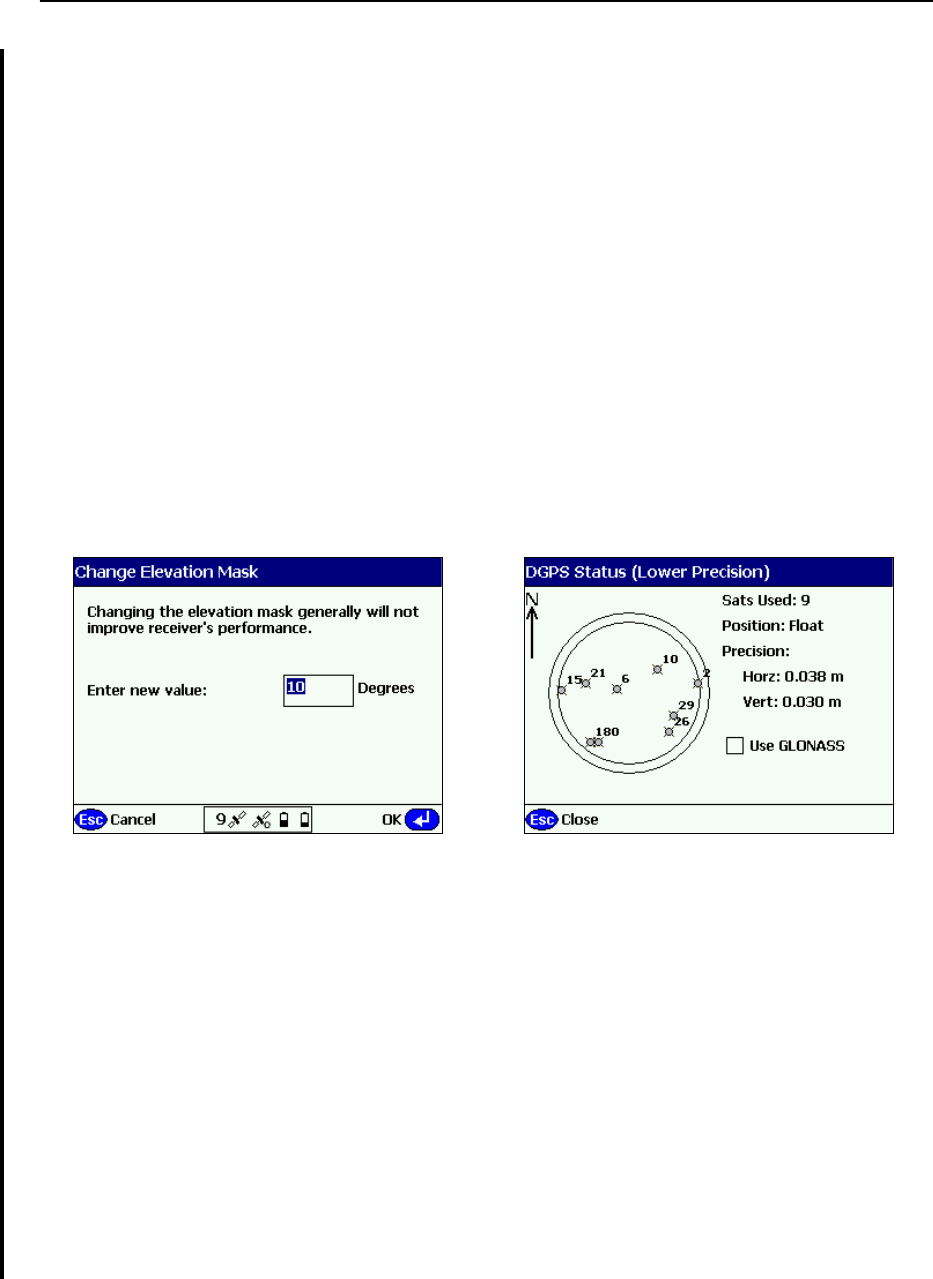
7 Configuring the Receiver Settings
76 SPSx50 Modular GPS Receiver User Guide
Using the SCS900 Site Controller software to configure the
base station, rover, and the radios
As a total system solution for construction applications, the SPS GPS receivers are
operated by a TSCe™, ACU, TCU, or TSC2 controller running the SCS900 Site
Controller software. The SCS900 system provides the tools to configure and start the
GPS receiver in the modes used by the SCS900 system: Base Station, RTK Rover,
Location RTK Rover, OmniSTAR Rover, and DGPS Rover using SBAS (WAAS/EGNOS
and MSAS). The SCS900 software provide wizards to help you through the process and,
where possible, assigns suitable default operational parameters to the system. This
eliminates the need for an operator to know how to configure the receiver with the
right settings.
The SCS900 system takes care of operating the receiver with both internal and external
radios, cellular communications components (modems and cellphones), and use of the
Bluetooth wireless technology. The software also takes care of scanning
communication ports to identify connected devices, and offers selection options
wherever necessary often with pictures to facilitate the correct component selection at
times when it cannot automatically identify the connected component, for example,
GPS antennas.
The SCS900 system allows you to specify operational tolerances, which have to be
achieved for measurements to be accepted. When outside of these tolerances, the
SCS900 system warns you through on-screen messages or indications, and the non
automatic acceptance of recorded positions. To set operational tolerances, go to the
the Settings menu in the SCS900 software.
Configuring the receiver to log data for postprocessing
The SPS GPS receivers do not come equipped with the Data Logging option. The
receivers can have this added either at the time of purchase, or at a later date as an
option. With the Data Logging option enabled, the receiver has available memory, that
facilitates the collection of GPS observations over a period of time, which can be used
with GPS postprocessing software such as Trimble Geomatics Office or Trimble Total
Control, for the computation of control networks and baselines.
The SCS900 Sky Plot screenPress Ctrl+M to open this screen

SPSx50 Modular GPS Receiver User Guide 77
Configuring the Receiver Settings 7
The SCS900 system does not provide support for postprocessed applications. Trimble
recommends that you use either the front panel keypad and display, the Web User
Interface, or (SPS770, SPSx80 only) the GPS Configurator software to configure the
receiver for postprocessed measurement sessions.
Configuring Ethernet Settings
The SPSx50 receiver has an Ethernet port so that the receiver can connect to an
Ethernet network. The receiver can be accessed across the network giving you the
ability to configure and monitor the receiver without needing to connect to the
receiver with a serial cable.
The SPSx50 receiver requires the following Ethernet settings:
•IP setup: Static or DHCP
•IP address
•Netmask
•Broadcast
•Gateway
•DNS address
•HTTP port
The factory default configuration of the SPSx50 receiver is to use DHCP. Using DHCP
enables the receiver to obtain the IP address, Netmask, Broadcast, Gateway, and DNS
address from the network. The default setting for the HTTP port is 80. The HTTP port
is not assigned by the network. HTTP port 80 is the standard port for web servers. This
allows you to connect to the receiver by entering only the IP address of the receiver in a
web browser. If the SPSx50 receiver is set up to use a port other than 80, you will need
to enter the IP address followed by the port number in a web browser.
Example of connecting to the receiver using port 80: http://169.254.1.0
Example of connecting to the receiver using port 4000: http://169.254.1.0:4000
When an SPSx50 receiver is connected to a
network using DHCP, an IP address is assigned
to the receiver by the network. To verify the IP
address of the receiver, select the up button
from the keypad when the Home screen is
displayed. The display will show the Ethernet IP address as shown.
If your network installation requires the receiver to be configured with a static IP
address, you can configure the Ethernet settings using the web server or the WinFlash
software. The web server can be only used when the receiver is connected to a network
and has a valid Ethernet configuration.
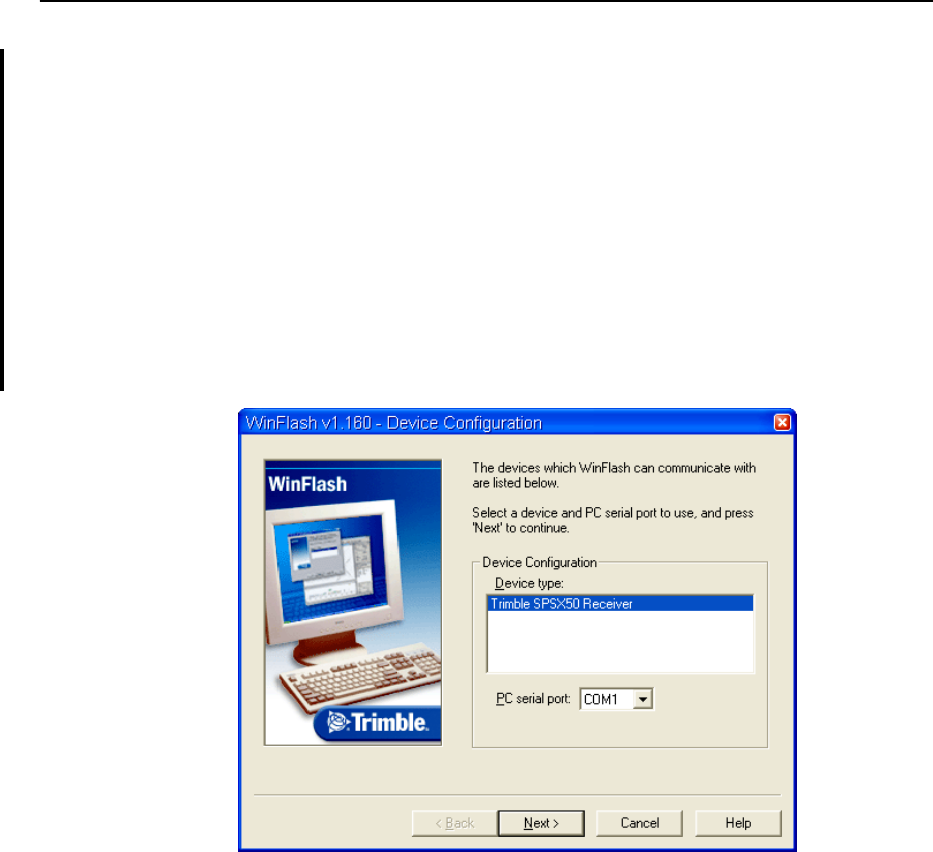
7 Configuring the Receiver Settings
78 SPSx50 Modular GPS Receiver User Guide
You should use the WinFlash software to configure the Ethernet settings of a receiver
that is to be connected to a network that requires static IP addresses. If a network
requires static IP addresses, contact the network administrator for the correct settings
for the SPSx50 receiver.
To configure the Ethernet settings using the WinFlash software:
1. Connect the SPSx50 receiver to a computer running the WinFlash software
using the serial cable provided with the receiver.
2. Turn on the SPSx50 receiver.
3. On the computer, start the WinFlash software.
4. From the Device screen, select Trimble SPSx50 Receiver, and then from the PC
serial port list, select the appropriate PC serial port. Click Next:
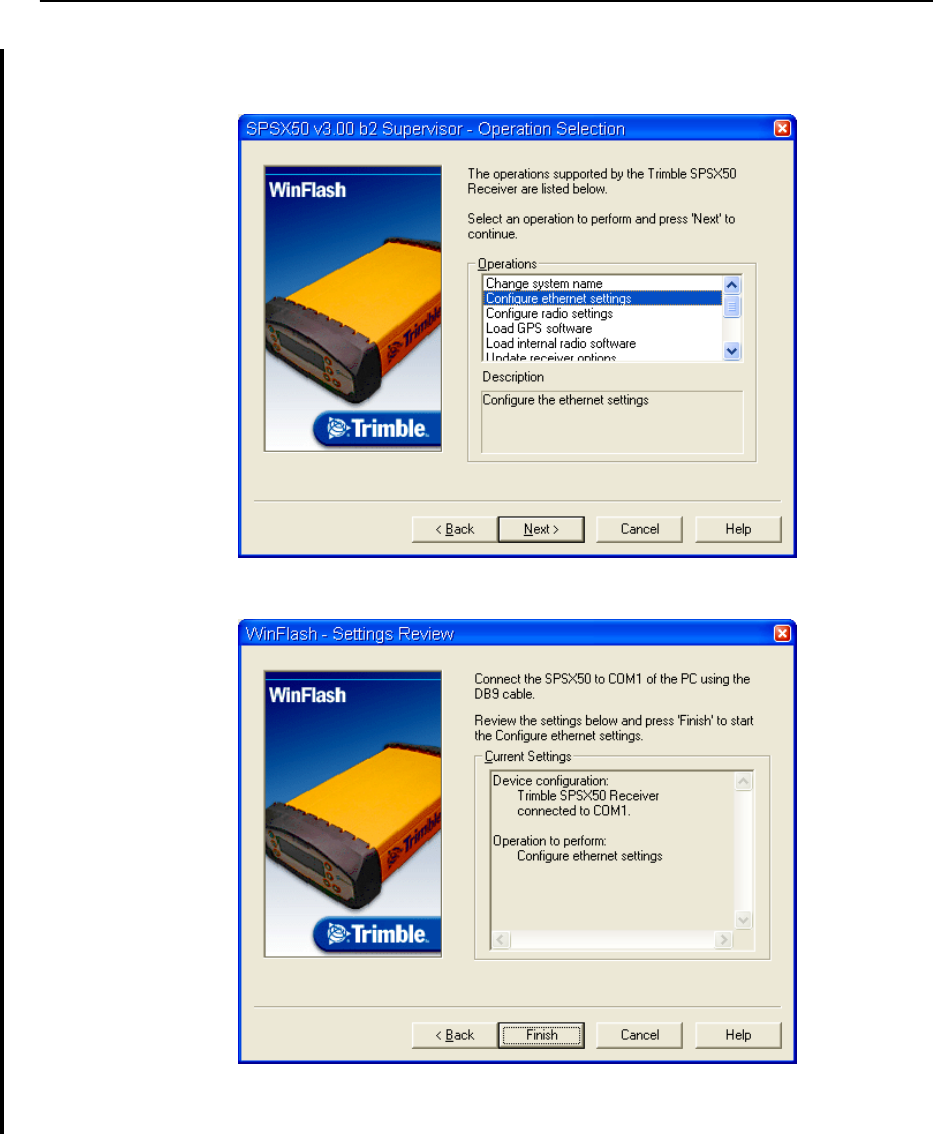
SPSx50 Modular GPS Receiver User Guide 79
Configuring the Receiver Settings 7
5. From the Operation Selection screen, select Configure ethernet settings, and then
click Next:
6. From the Settings Review screen, click Finish.
Once the WinFlash software connects to the receiver, the Ethernet Configuration
dialog appears.
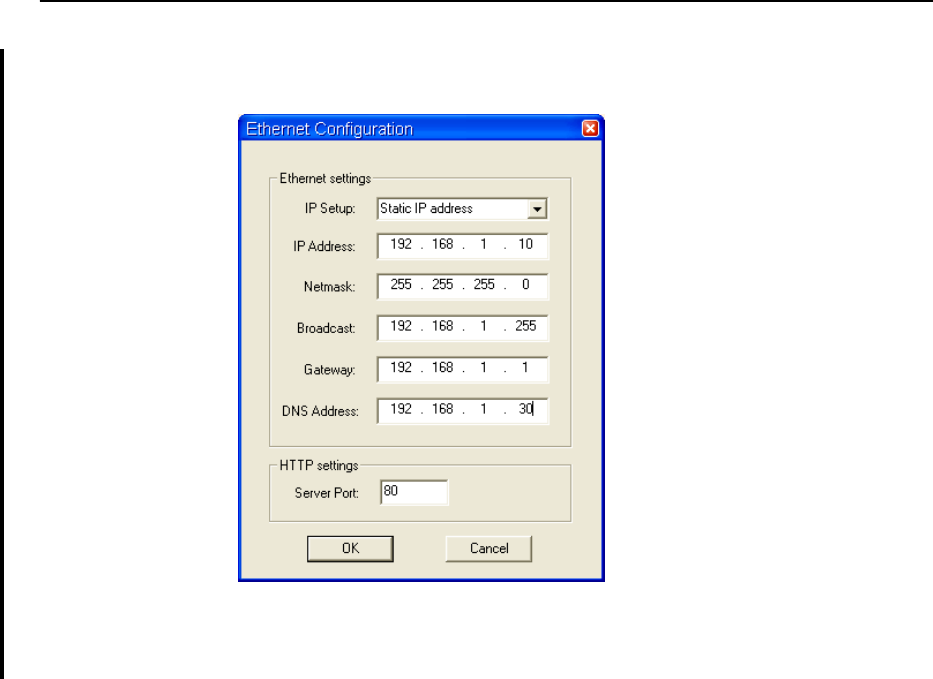
7 Configuring the Receiver Settings
80 SPSx50 Modular GPS Receiver User Guide
7. Enter the network settings (obtain these from your network administrator), and
then click OK:
The Broadcast setting is the IP address that is used to broadcast to all devices on
the subnet. This is usually the highest address in the subnet, which is usually
.255.